21 proven sales call tips for successful sales conversations
Google “sales call tips.”
In .43 seconds, you’ll see that the Internet has no shortage of articles about making better sales calls.
And many — even most — of these articles are great.
They have extremely solid advice.
So what makes these the 21 best sales call tips you’ll ever read?
That’s a high bar we’ve set for ourselves.
But here’s the answer.
These are the only sales call tips backed by data.
That doesn’t make the other articles irrelevant.
Far from it.
In fact, many of these sales call tips simply confirm what these other articles talk about.
Others, however, are incredibly counterintuitive.
Our data team has analyzed nearly 2 million sales calls with AI and machine learning to find out exactly what works on sales calls.
We’ve pulled almost everything we learned into this post.
So from our brains to yours, here are the 21 best tips you’ll ever read about sales calls.
Soak them in.
Before your next sales call: download this 10-point checklist for deal-making video calls. It has all the data-backed tips that the best-of-the-best sales pros use to boost their win rate (and their commission).
[newsletter title=”Grow Your Skills” call=”Get insanely effective sales tips sent to your inbox.”]
Sales call tip #1: schedule your sales call for the right time
Congrats on landing the sales meeting.
Let’s maximize your chance of it going well.
There are good and bad times of day for the first sales meeting.
Know when they are?
If you think a morning-fresh, bright-eyed prospect is your best bet, guess again.
Afternoon calls have fewer no-shows and prospects stay on the call longer: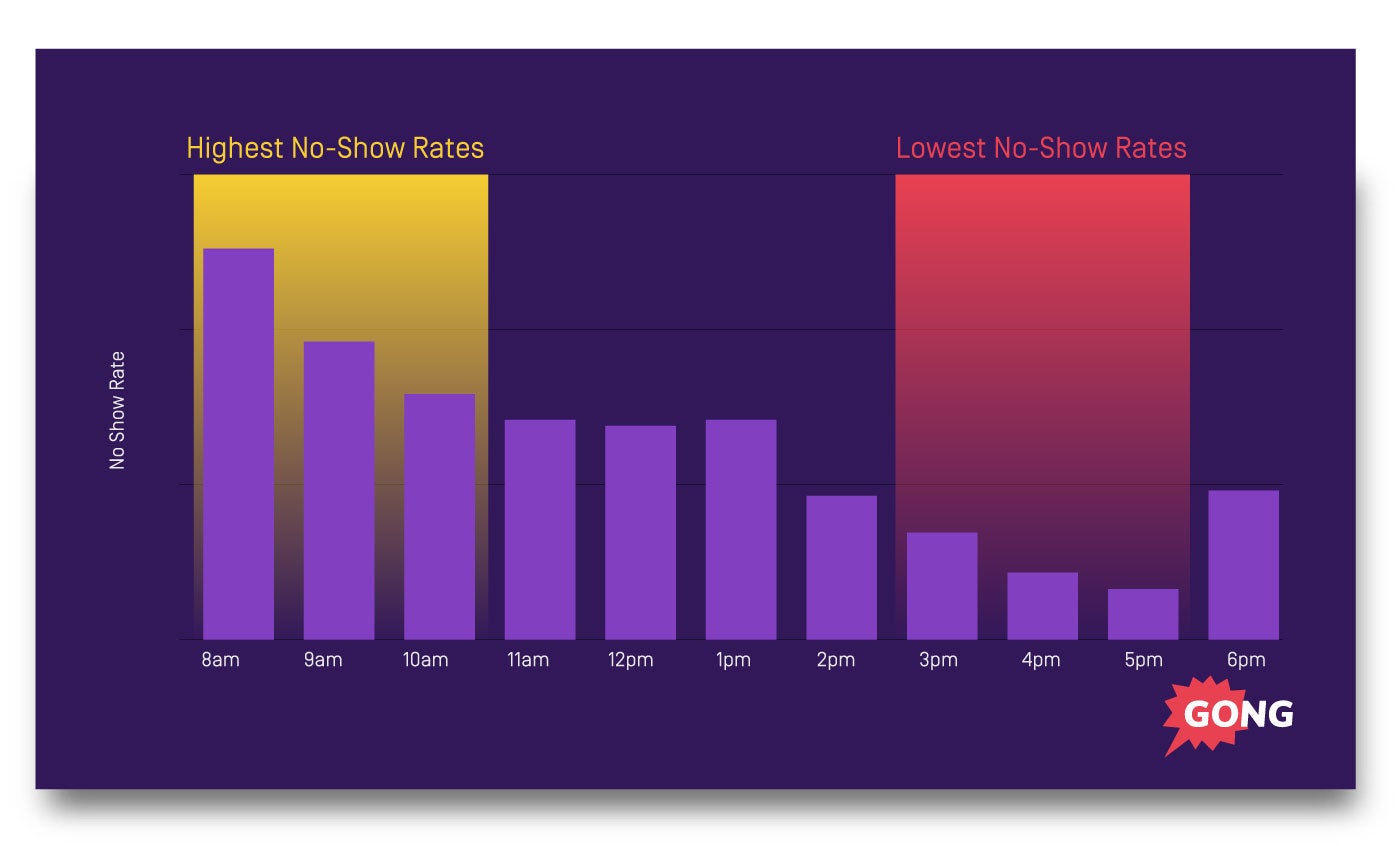
Mornings? Stay away from them.
Your prospect is 30% more likely to show up for a call at 4 PM than one at 8 AM.
This approach is counterintuitive, so most salespeople get it wrong:
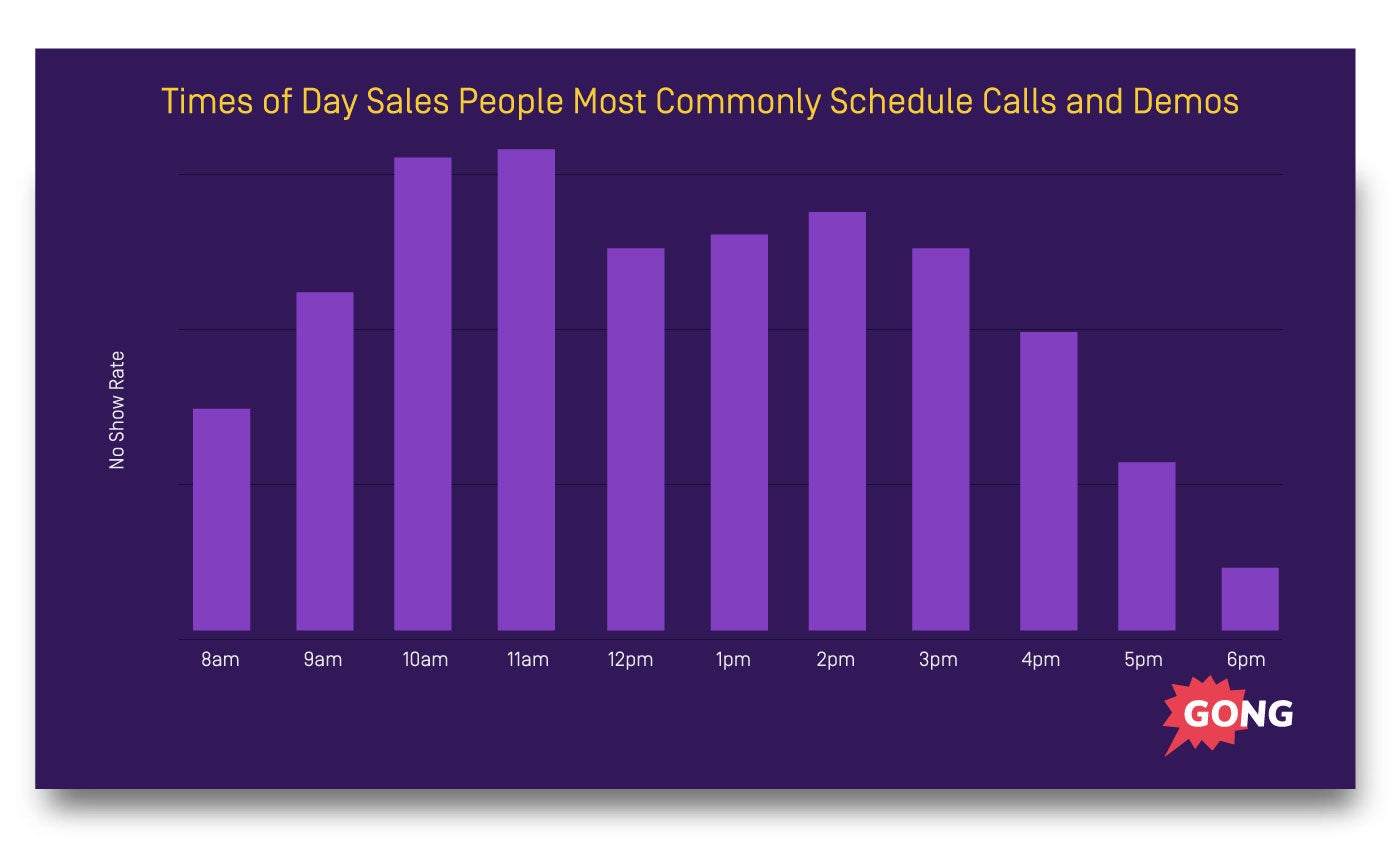
When we looked at the day of the week, we found it doesn’t matter much at all.
Go forth, and schedule!
Sales call tip #2: structure your sales call
Your sales call is not the time to find out whether you rock at improv.
The world’s top salespeople never “wing it.”
In fact, the top 5-10% of them have an incredibly organized and repeatable sales call process.
For starters, they cover more topics than poor or average performers: 15 compared to 12 on a 43-minute call:
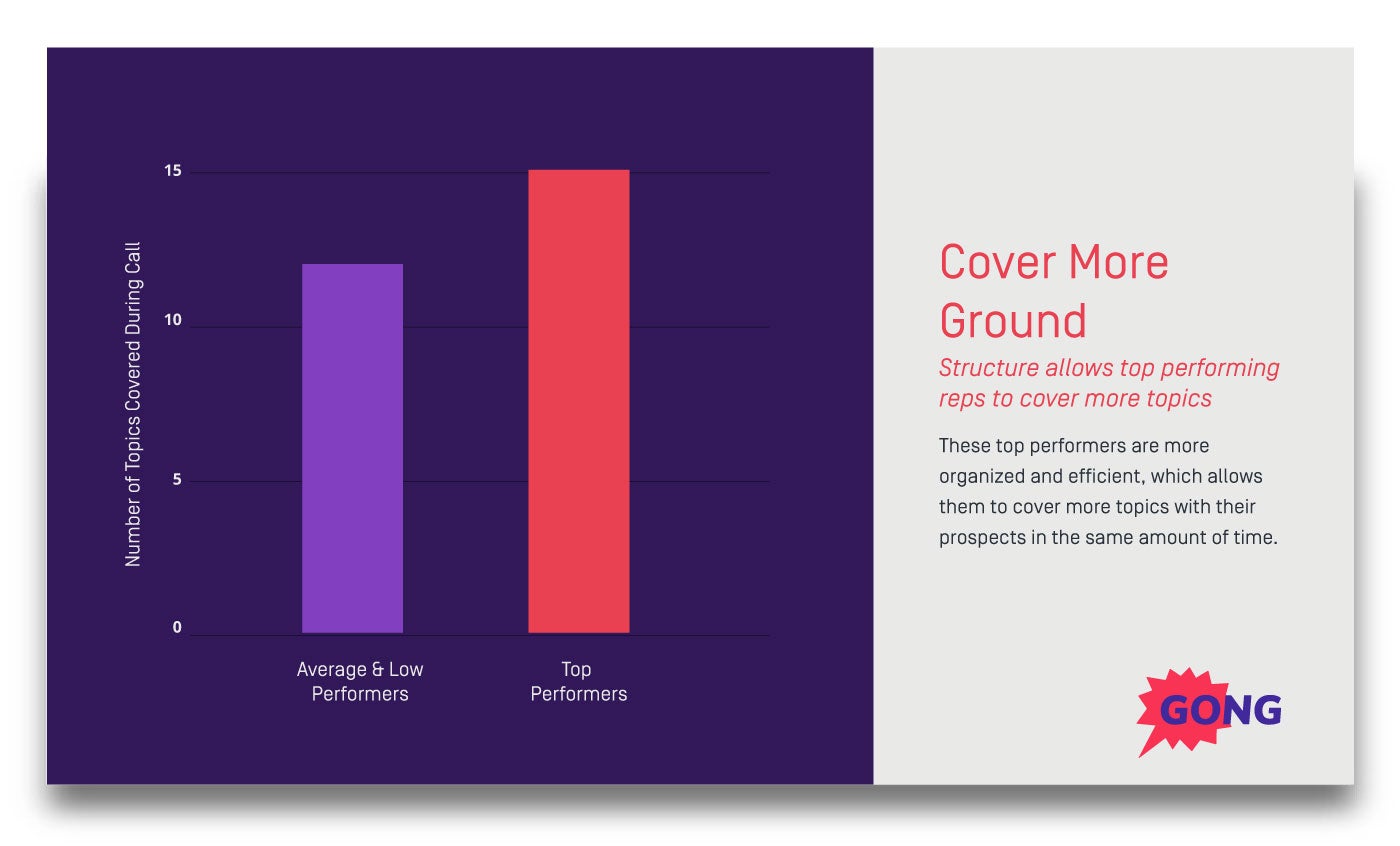
Their conversations are linear.
Top reps use overarching themes and move smoothly within them from one topic to the next.
Meanwhile, average and low-performers offer their prospects a rollercoaster of haphazard topics.
Don’t. It gets ugly:
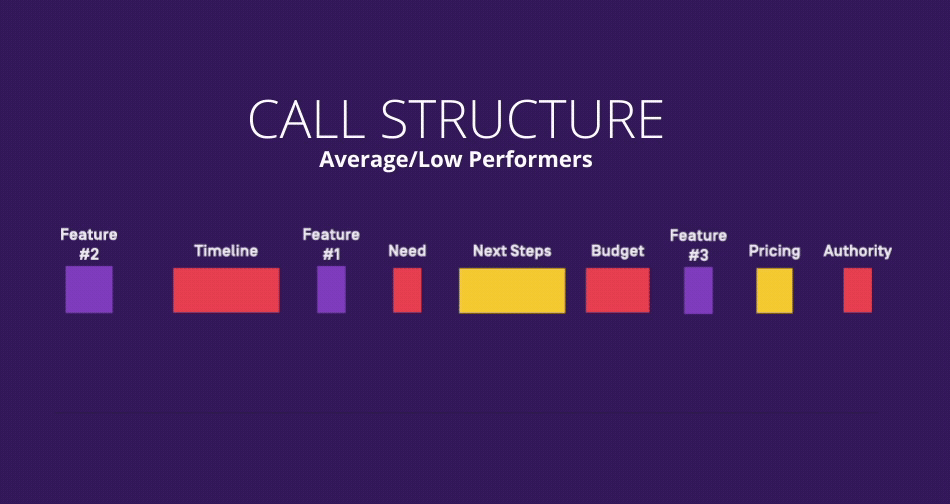
If you cluster topics thematically, you’ll “switch” topics during your conversation 15.6% less frequently than average or poor performers:
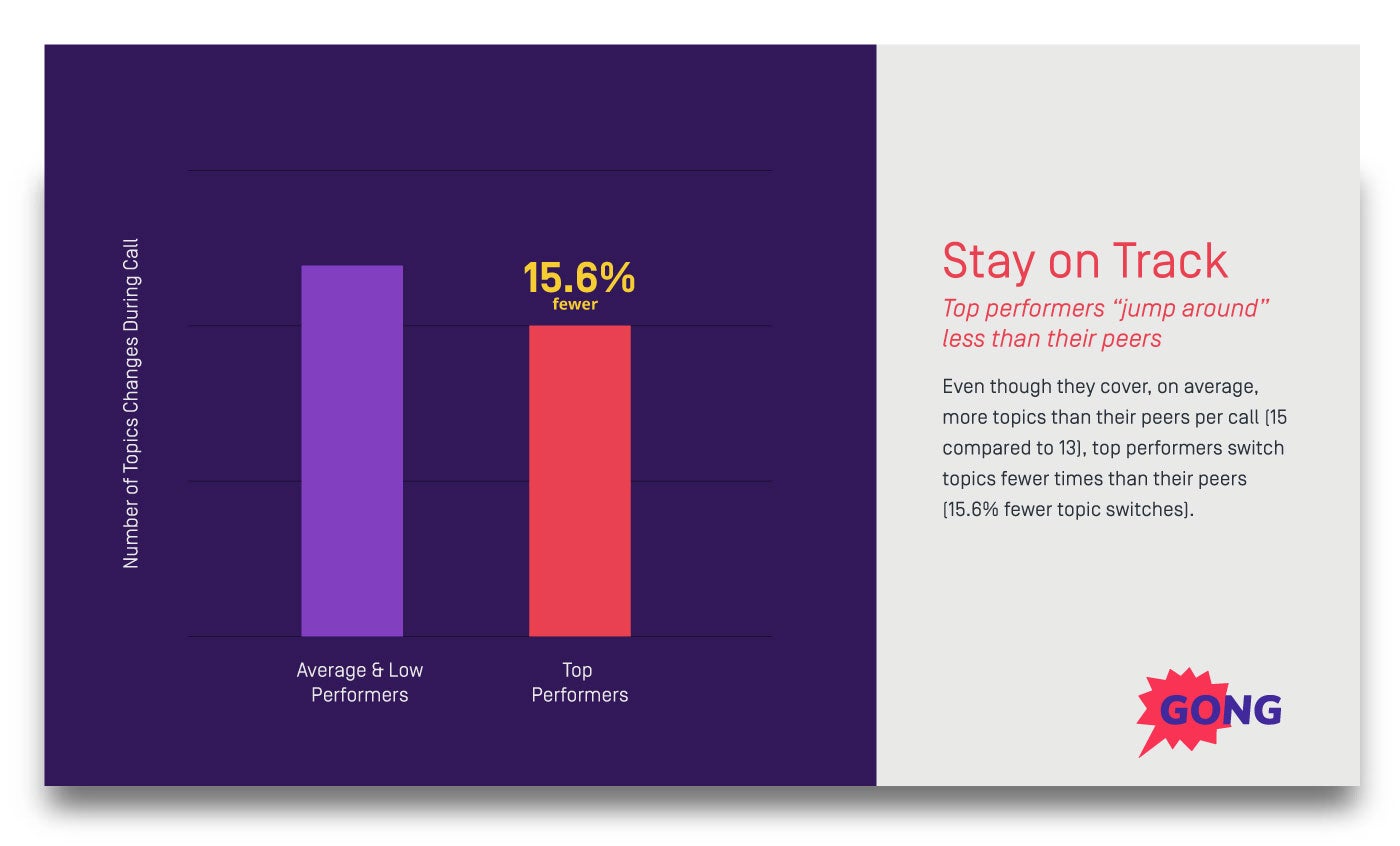
The key point?
PREPARE for your sales call like your job depends on it.
Because it does.
Sales call tip #3: start your sales call right
This sales call tip is an extension of the last one.
A great sales call structure starts with a great “opening” to the meeting.
Here’s how we’ve seen the best salespeople start their sales meetings:
- Start with small talk: A rookie mistake that green, overeager sales reps make is they dive straight into business as soon as the prospect hops on the conference call. It comes across as robotic. Instead, spend a few minutes warming up the tone of the call.
- Propose an agenda: Use this line: “I’d like to set an agenda for this meeting so we can cover as much ground as possible. Is that alright with you?” Then, propose your agenda, and ask the prospect if they’d like to add or remove anything from it. If they do, that’s great! It means they’ll feel more of a sense of ownership of the meeting.
- Set an upfront contract: This simply means that you’re getting the prospect to agree to schedule a next step (or ending the meeting without one clearly) at the beginning of the meeting. It helps you avoid “maybe” land where your prospect goes dark, and you don’t know if she’s interested. Try saying something like this: “The sole objective of this meeting is simply to determine if we should schedule a second meeting. So by the end of this meeting, I’d like you to be in a position where either 1) You see value in this, want to explore further, and we schedule the next logical step, or 2) You don’t see value in this, at least for now, and we cleanly go our separate ways. Is that fair?”
Sales call tip #4: nail your talk-to-listen ratio
Here’s the crux of it:
The perfect talk-to-listen ratio depends on the type of sales call you’re making.
Cold calling, for example, is a major outlier.
It’s the only time in the sales process when you can talk more than you listen:
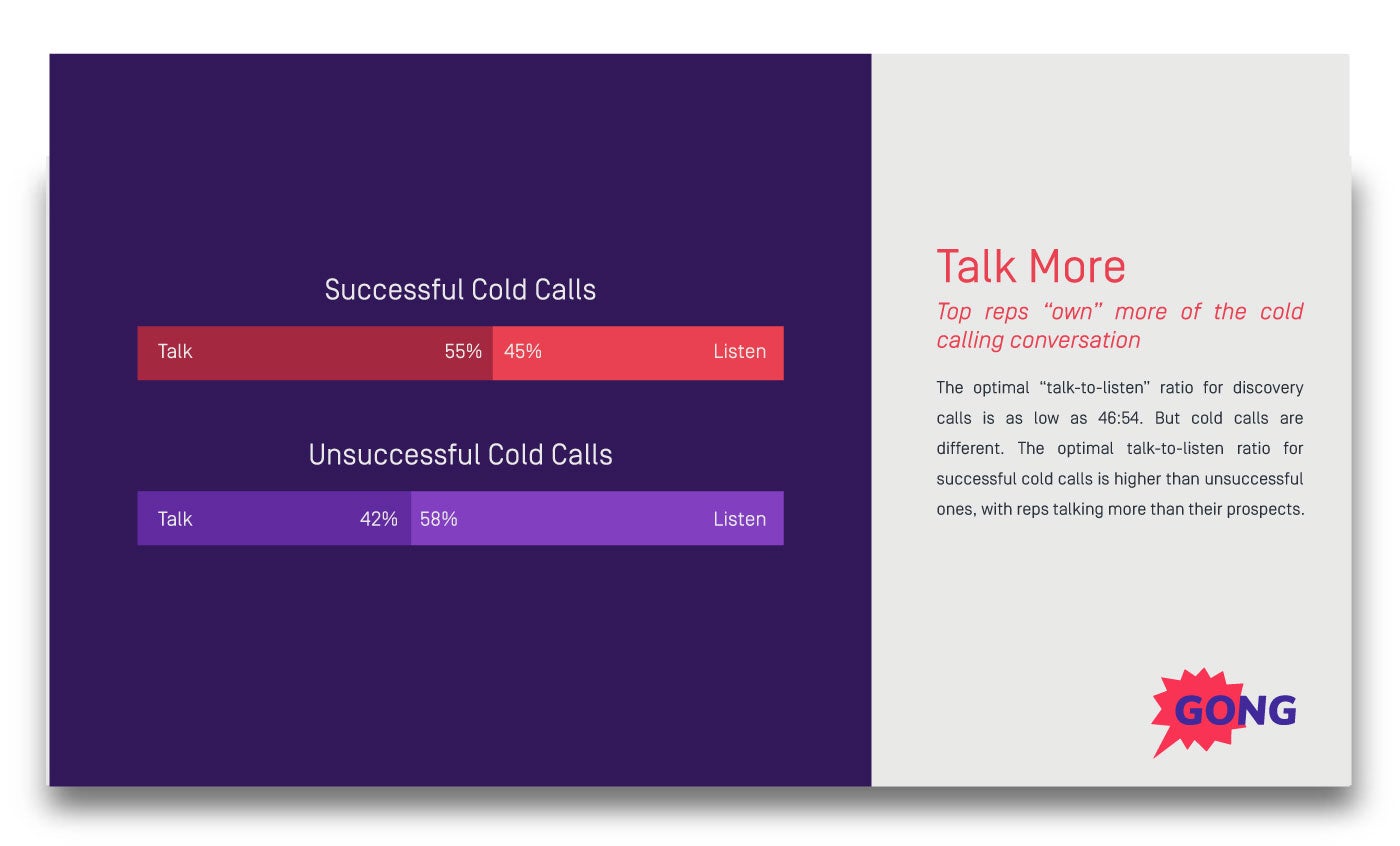 Cold calls are about grabbing your listener’s attention.
Cold calls are about grabbing your listener’s attention.
Sometimes that means you need to talk more, even up to 37 seconds: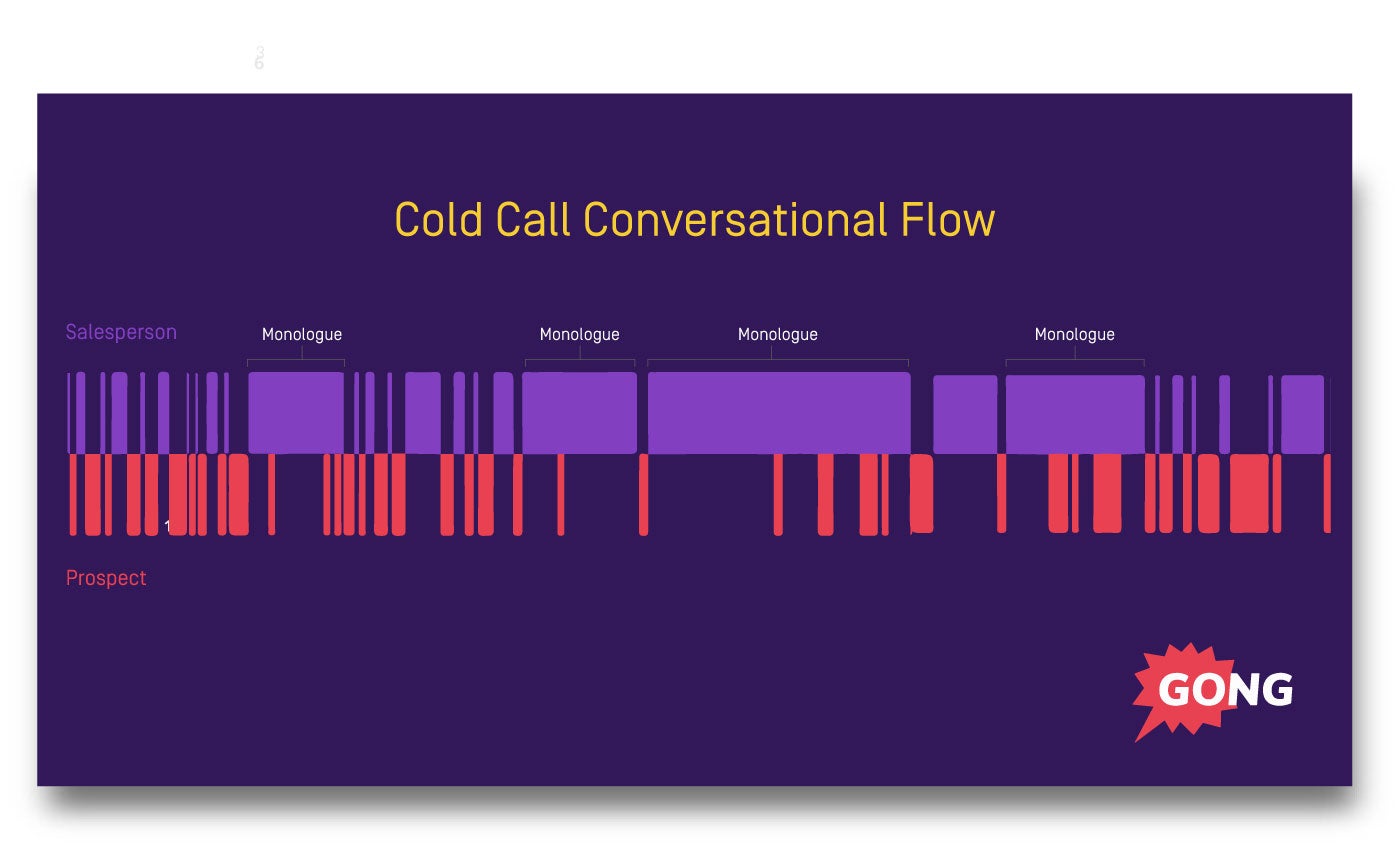
If you talk for 25 seconds or less, you’re half as likely to book a meeting as reps who talk longer:
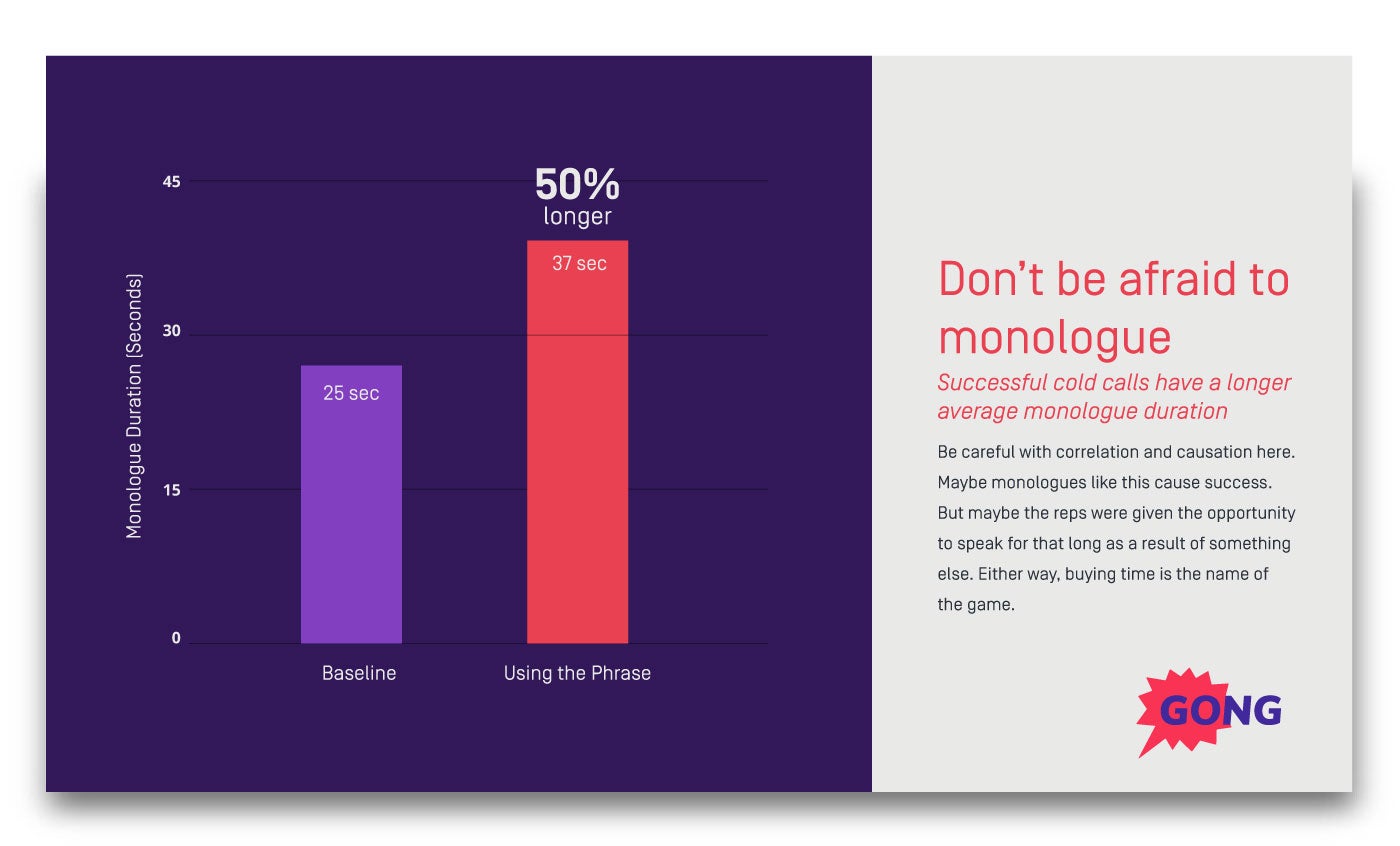
If you don’t talk, the prospect will, and (counterintuitively) that’s not ideal on a first call.
Look at how long prospects talks on successful (3.5 seconds) versus unsuccessful (8 seconds) cold calls: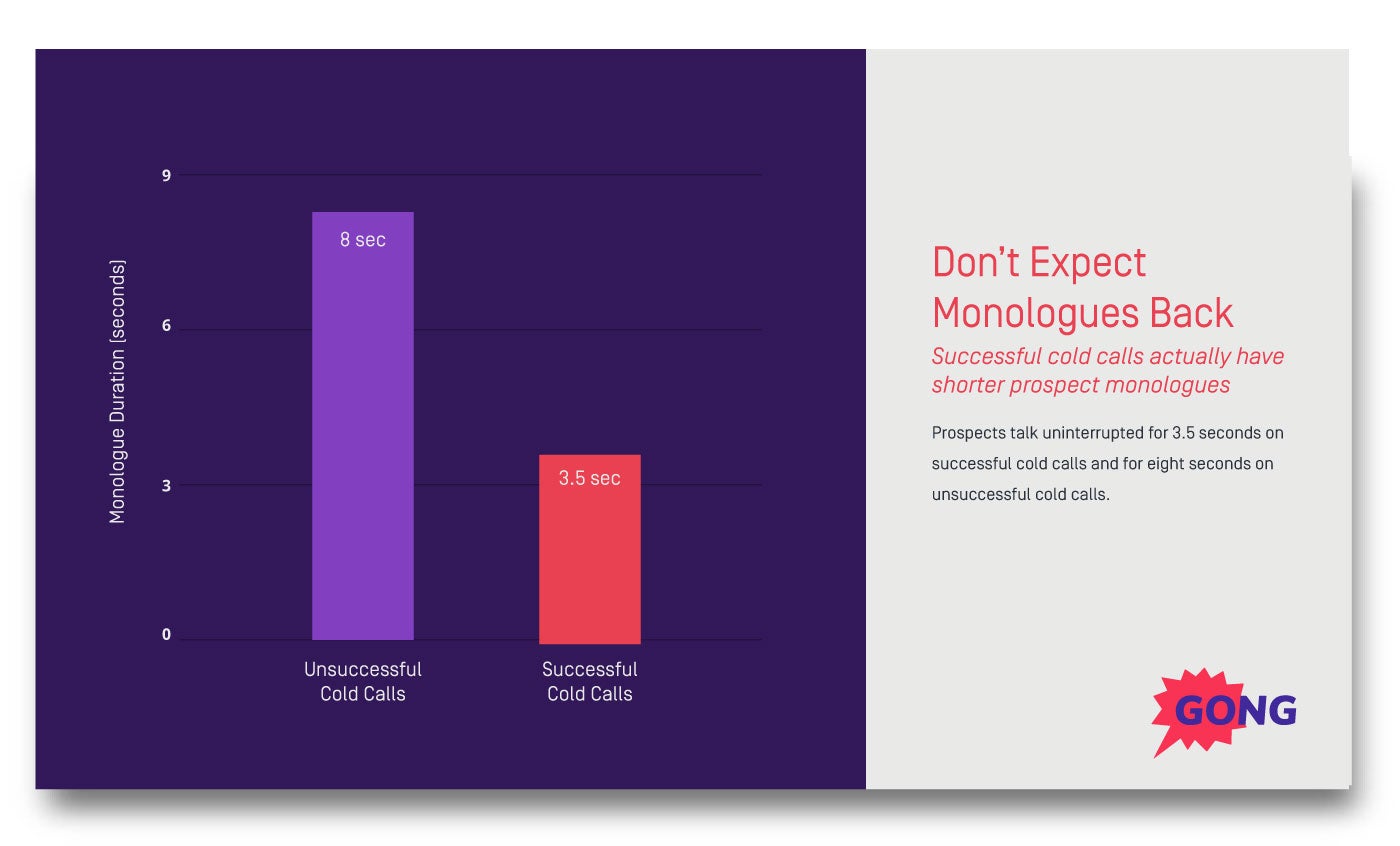
Mastered that concept? Good.
Now switch!
Everything changes for the discovery call.
You want connection. You want your prospect to feel heard.
Let the back and forth chatter get messy: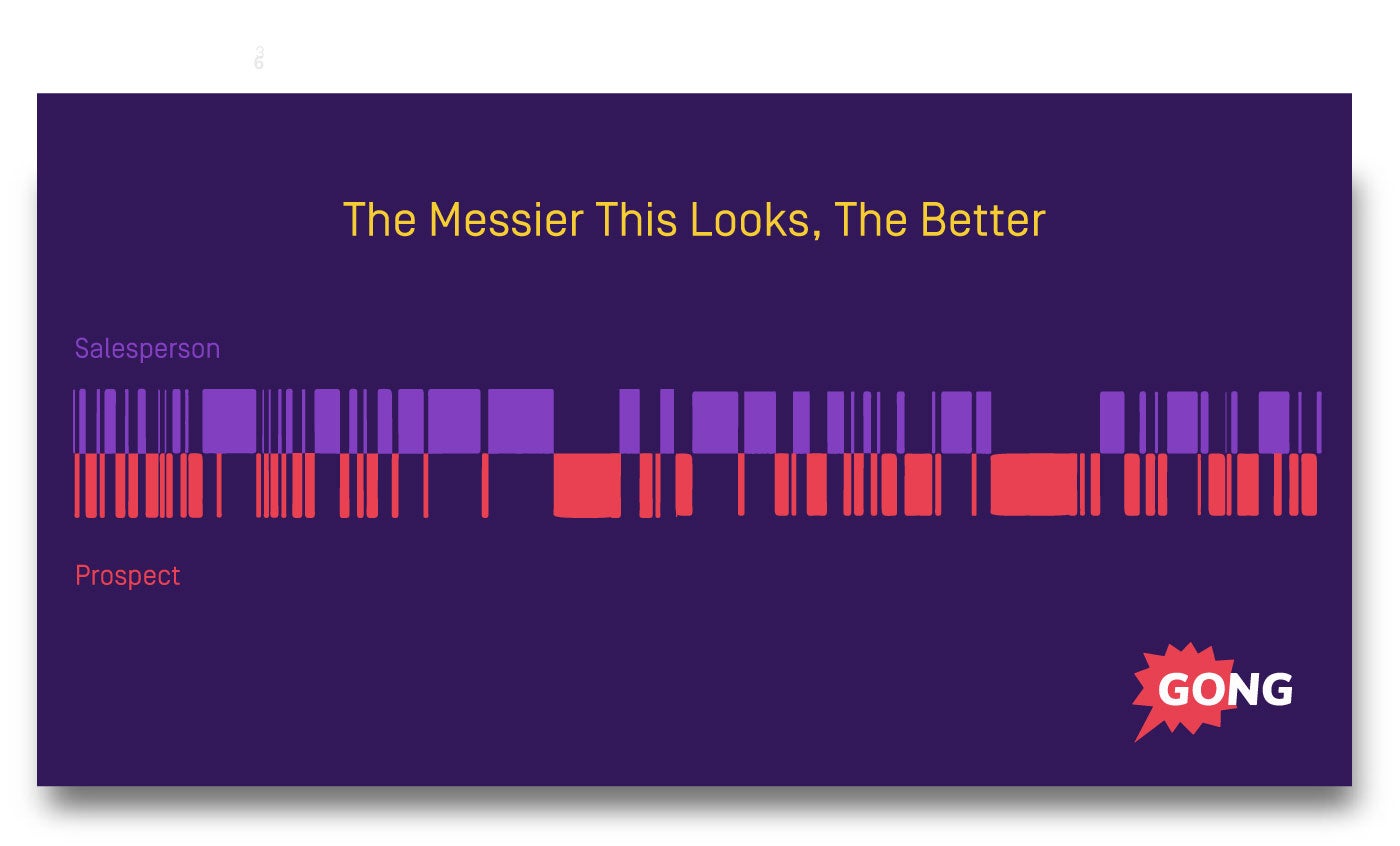
Listen a little more than you talk:
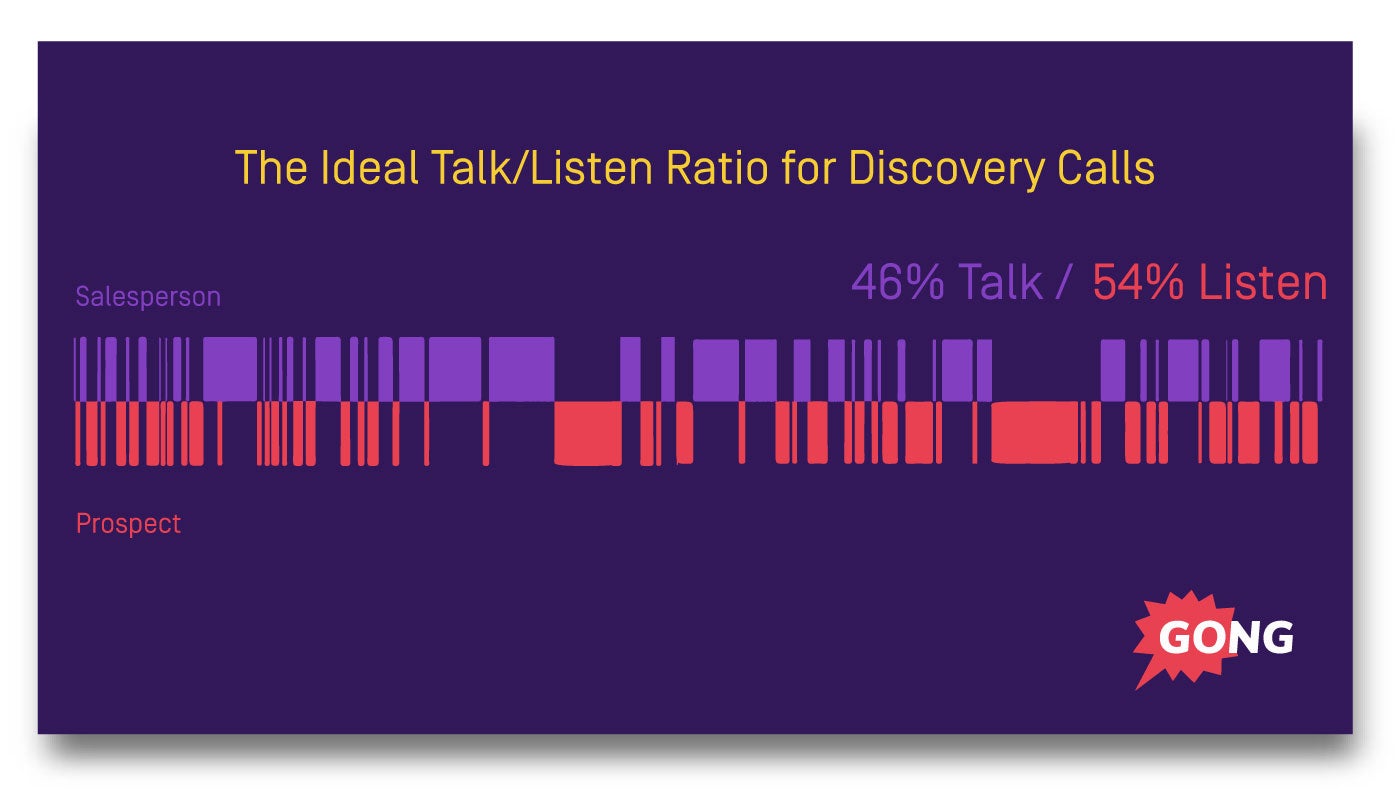
If you don’t, your talk-to-listen ratio will look more like that of average and low performers:
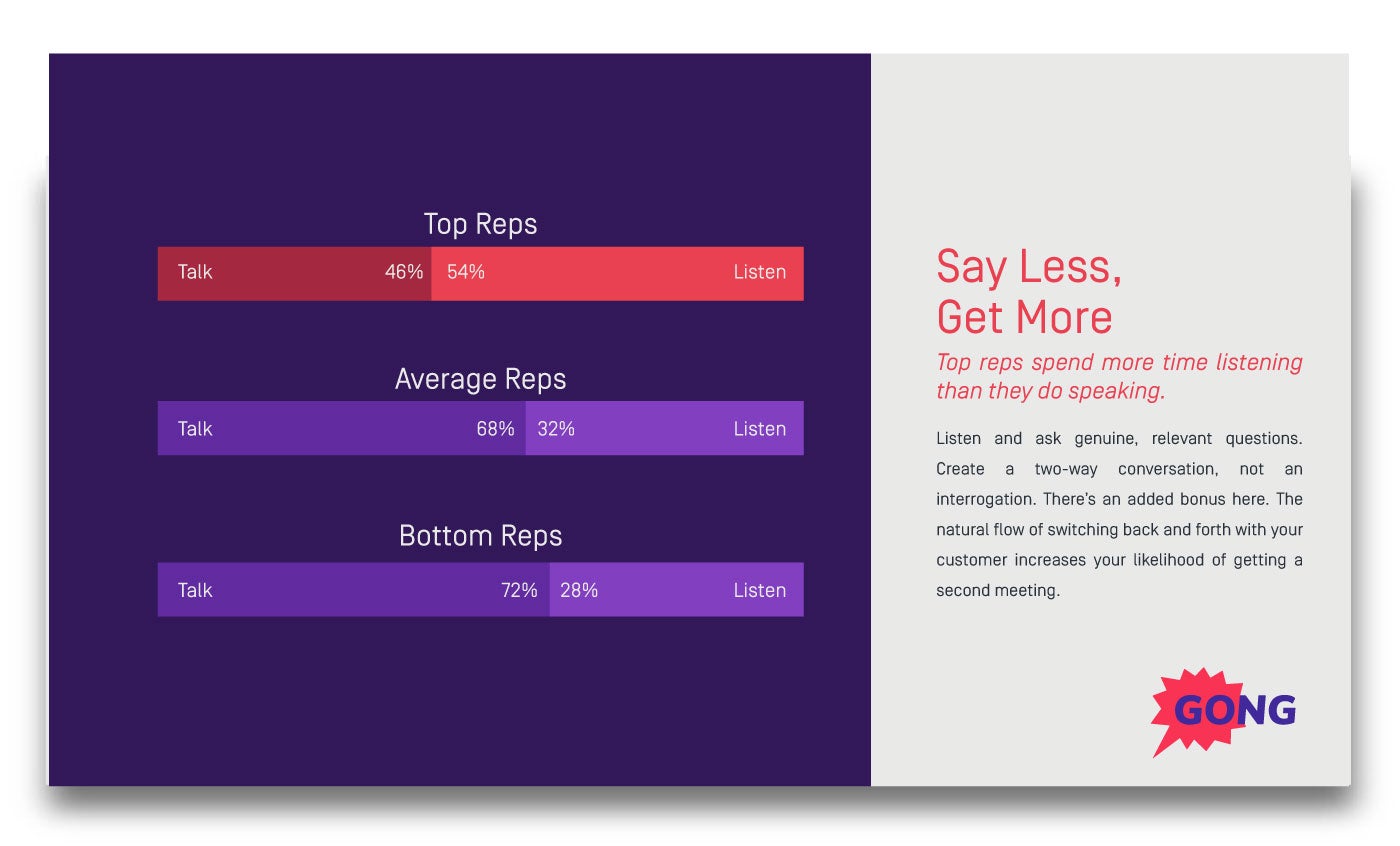
Nail your talk-to-listen ratio.
It will pay off.
Sales call tip #5: make it a two-way dialogue
Switching between speakers matters a lot early in the sales cycle.
You can use that two-way dialogue to build trust and understanding.
That’s why successful sales calls are almost twice as interactive as unsuccessful ones.

Sales call tip #6: build rapport the right way
Top salespeople are incredible at building rapport.
You can be too, without cheap tricks like mirroring.
Instead, learn to pull the prospect into your rhythms (volume, pitch, talking speed, and pauses).
That’s how the pros do it.
In fact, prospects will actually adjust their talking speed by 13% to conform with the top salespeople.
Top reps, on the other hand, only adjust their talking speed 1.7% of the time:
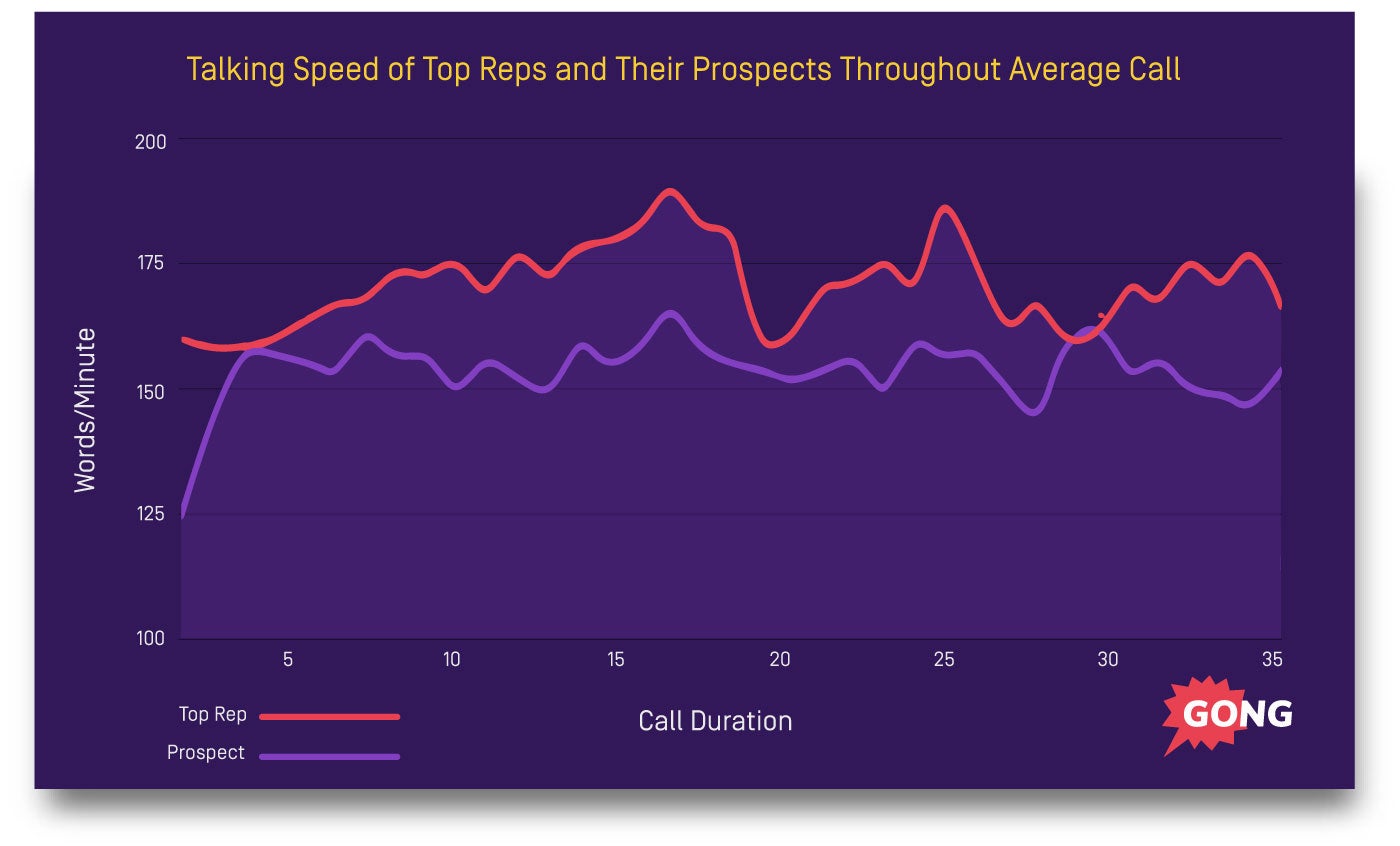
Average performers shift by 7% in the prospect’s direction, while the prospect hardly changes at all:
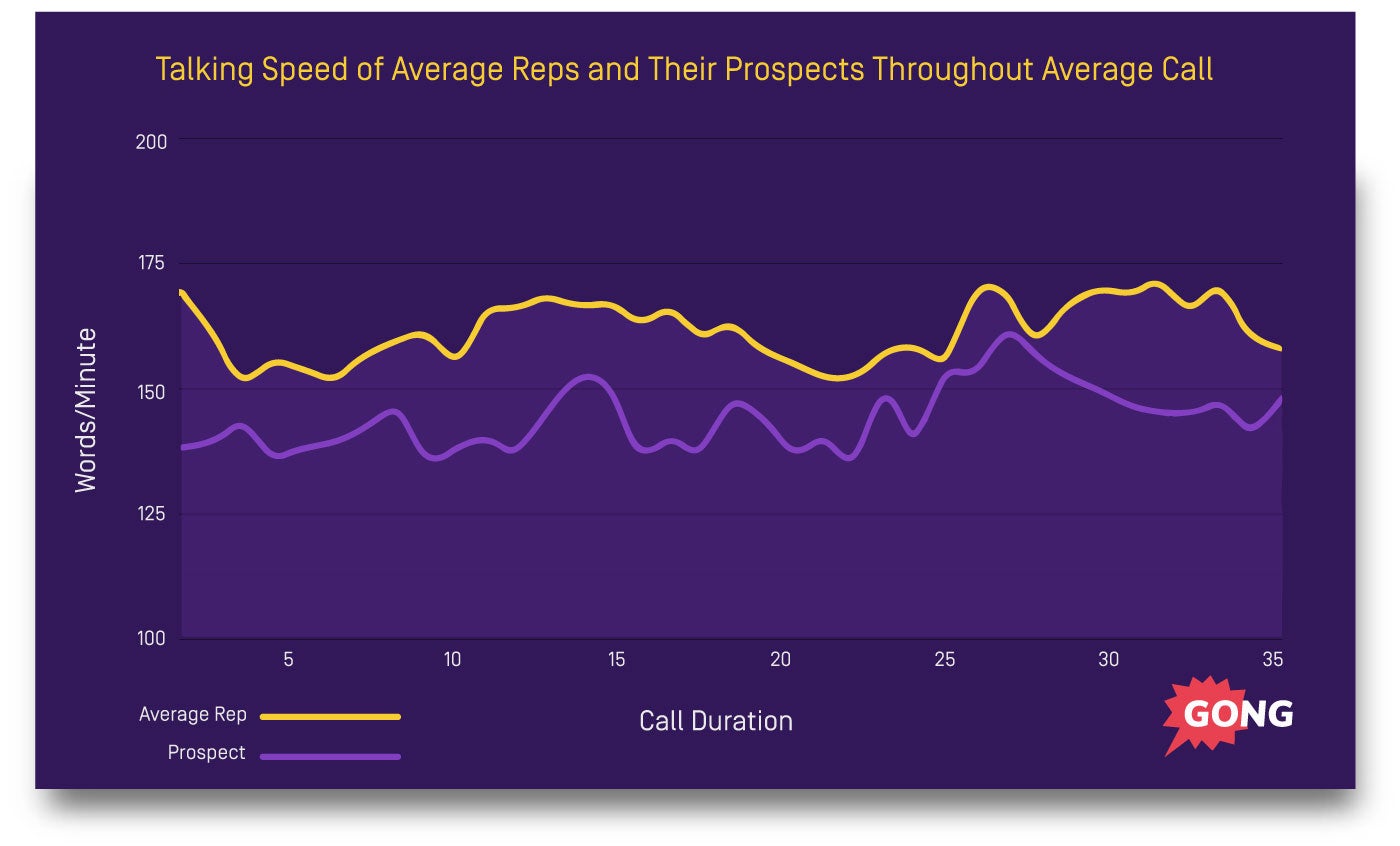
This pattern repeats itself when we measure positive and negative language in recorded calls.
Top reps don’t mirror negative prospects.
They stay the course and use more positive language until the prospect falls in line:
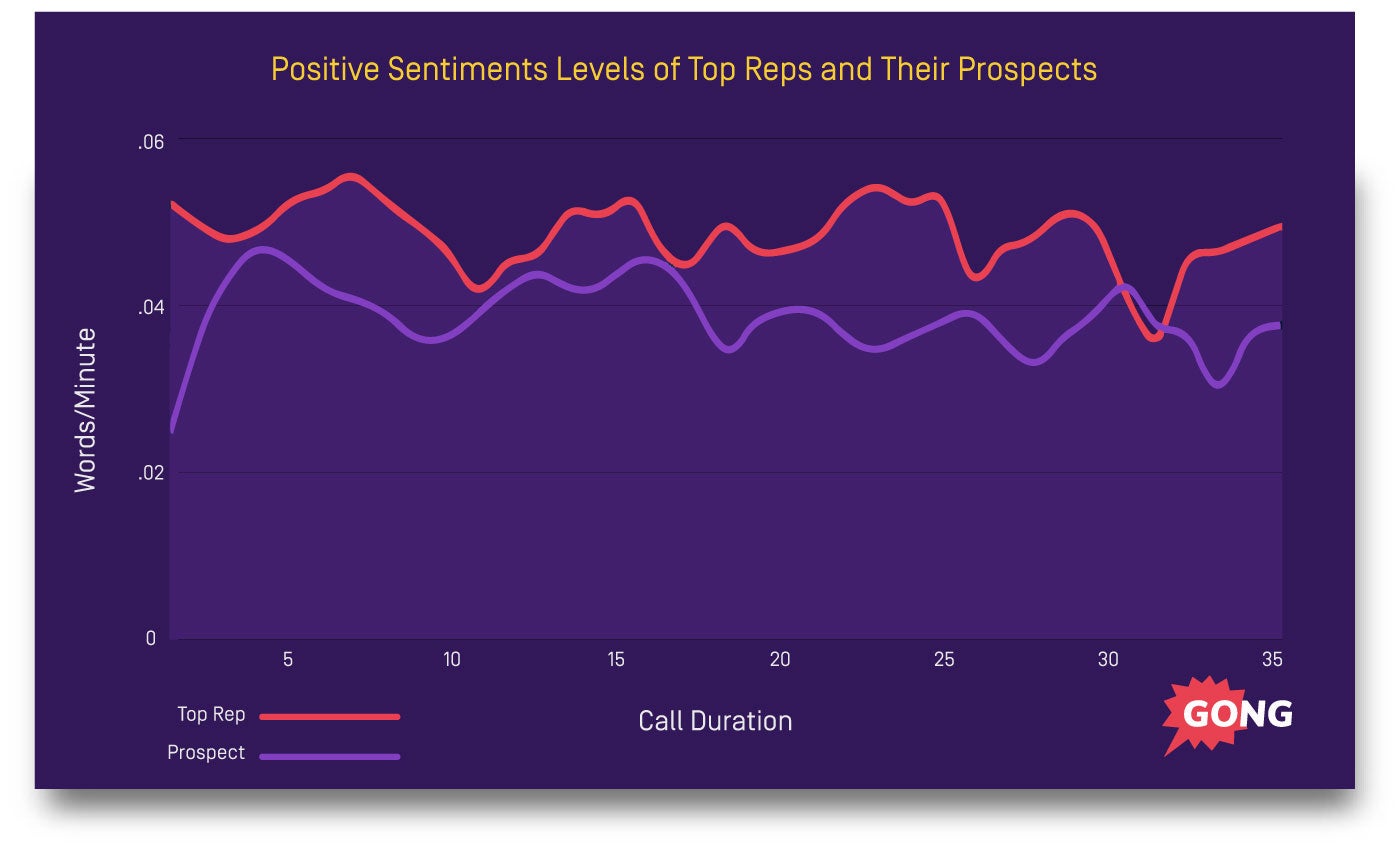
The lesson?
Don’t mirror other people. Be a leader. Let them follow you.
You’ll reach conversational synchrony around the 2-3 minute mark.
Sales call tip #7: transition your language as the sales call progresses
Words set the tone of your conversations.
That’s why even tiny language differences like using “I” or” we” matter.
They make you sound familiar or formal, unified or solo, so you want to use them at the right time.
For example, use “we” language when you want to warm your buyer up on a cold call.
That’s when the top salespeople use it to generate a sense of credibility:
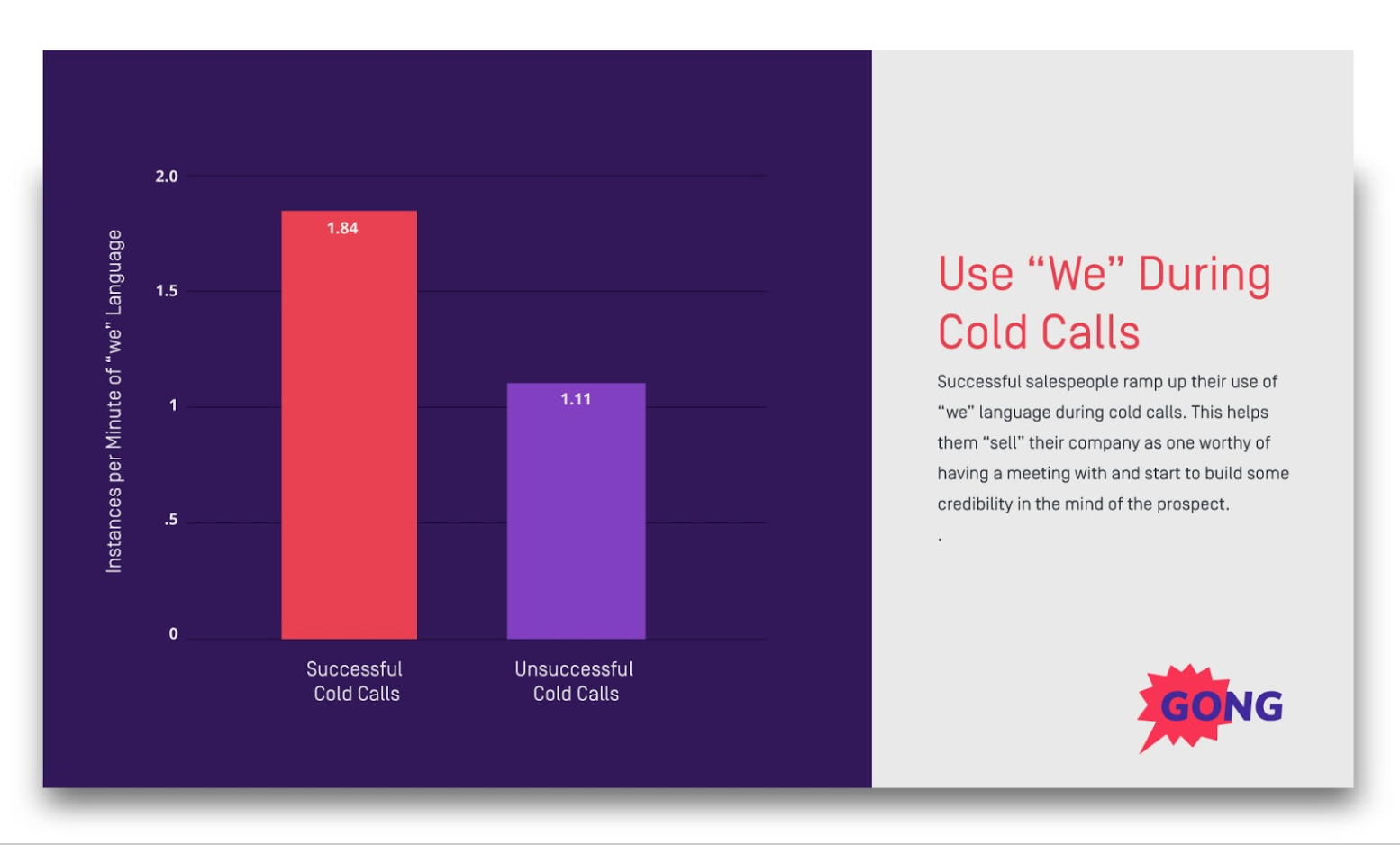
Don’t stop using “I’ language, just increase your use of “we” language.
It can help you book a first meeting.
And when you do, keep using “we” language in the first 4-6 minutes of that meeting:
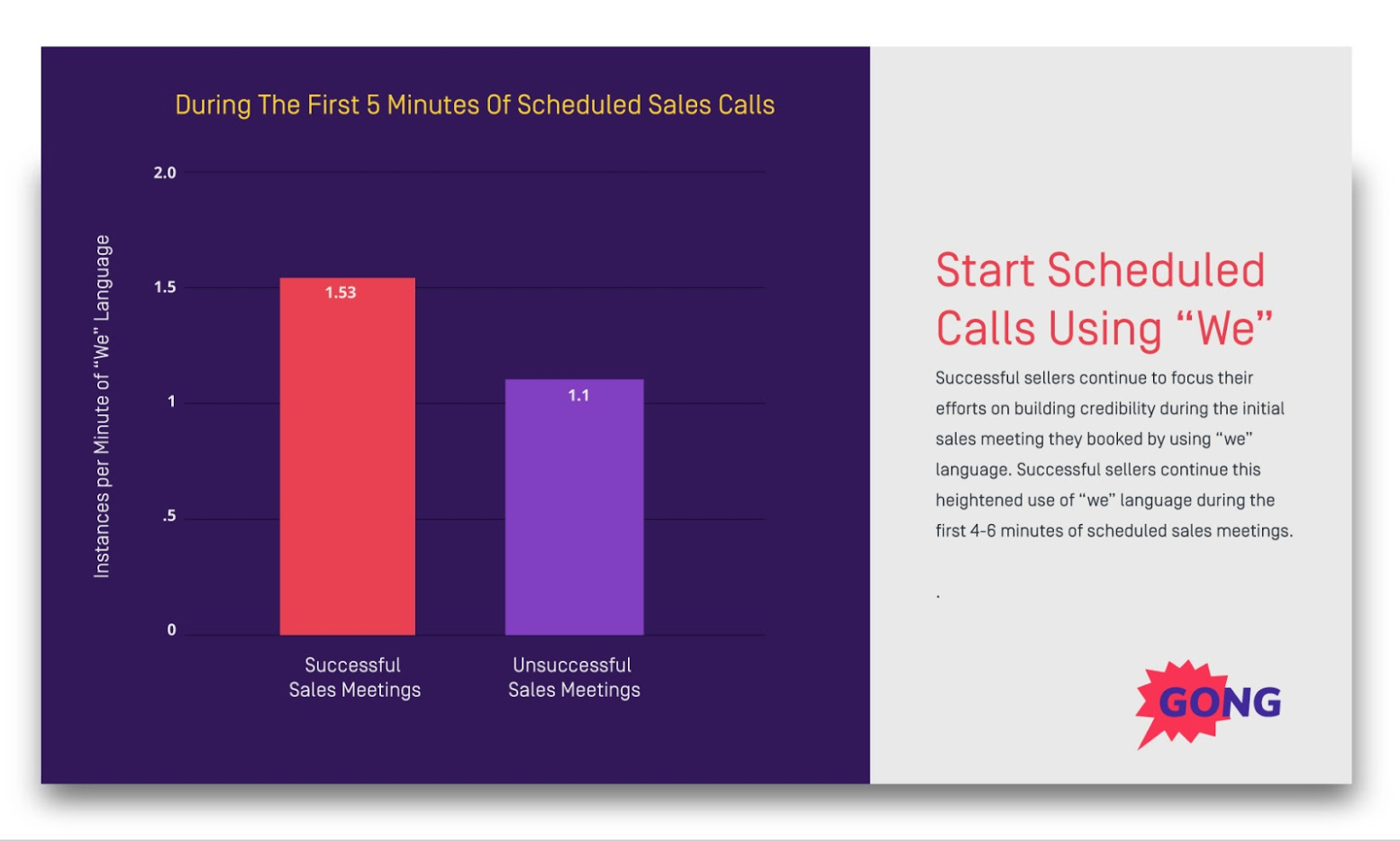
But don’t get too set on “we” language.
There’s a transition coming.
Around the 5-minute mark of the first sales meeting, start using more “I” language to build personal rapport:
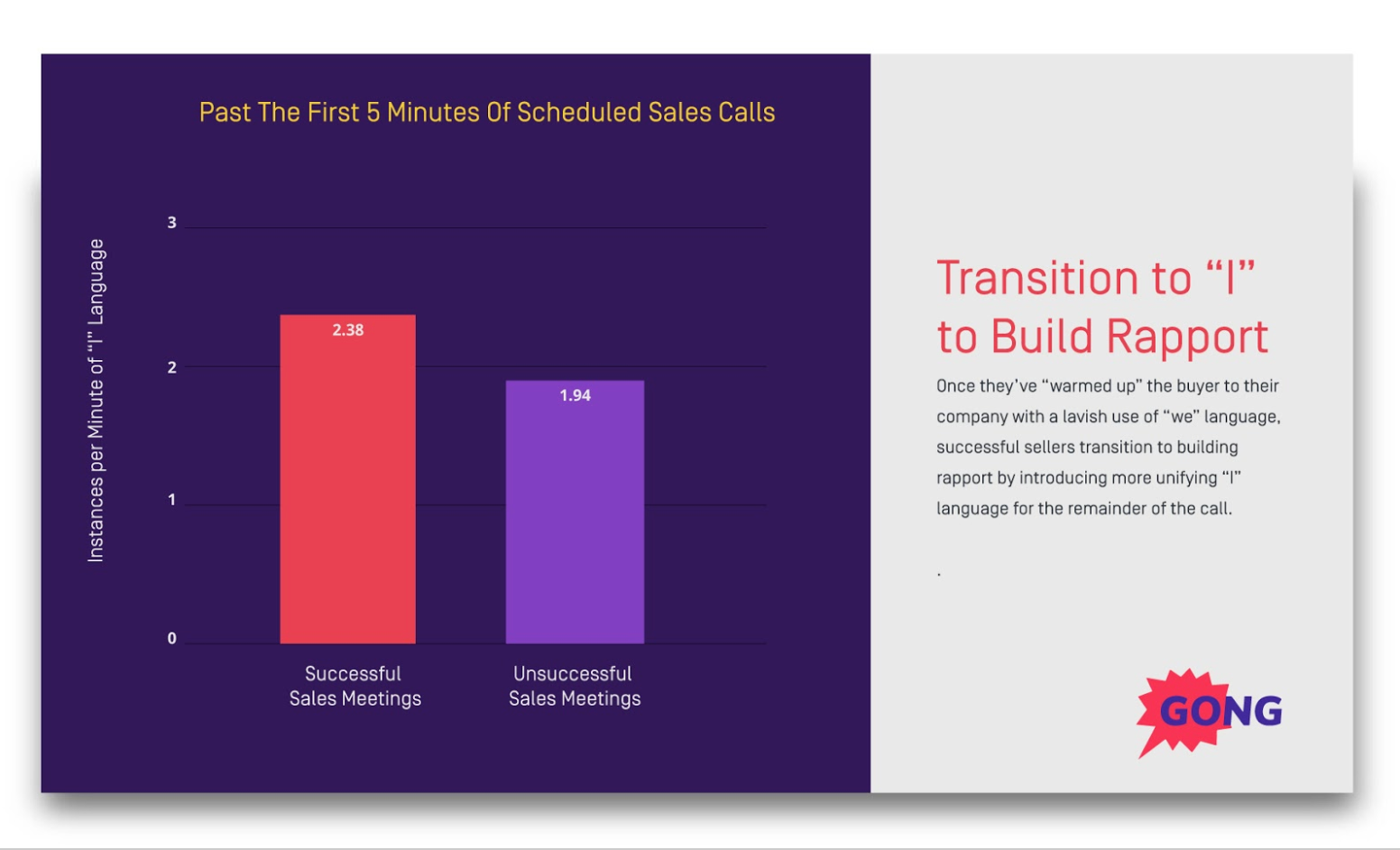
It moves the prospect from connecting with a company to connecting with a person.
Totally. Different. Ballgame.
Now you’re getting somewhere.
Sales call tip #8: ask the right number of questions
During your discovery call, dig into 3-4 of your prospect’s problems.
That’s the perfect number to keep the deal moving forward:
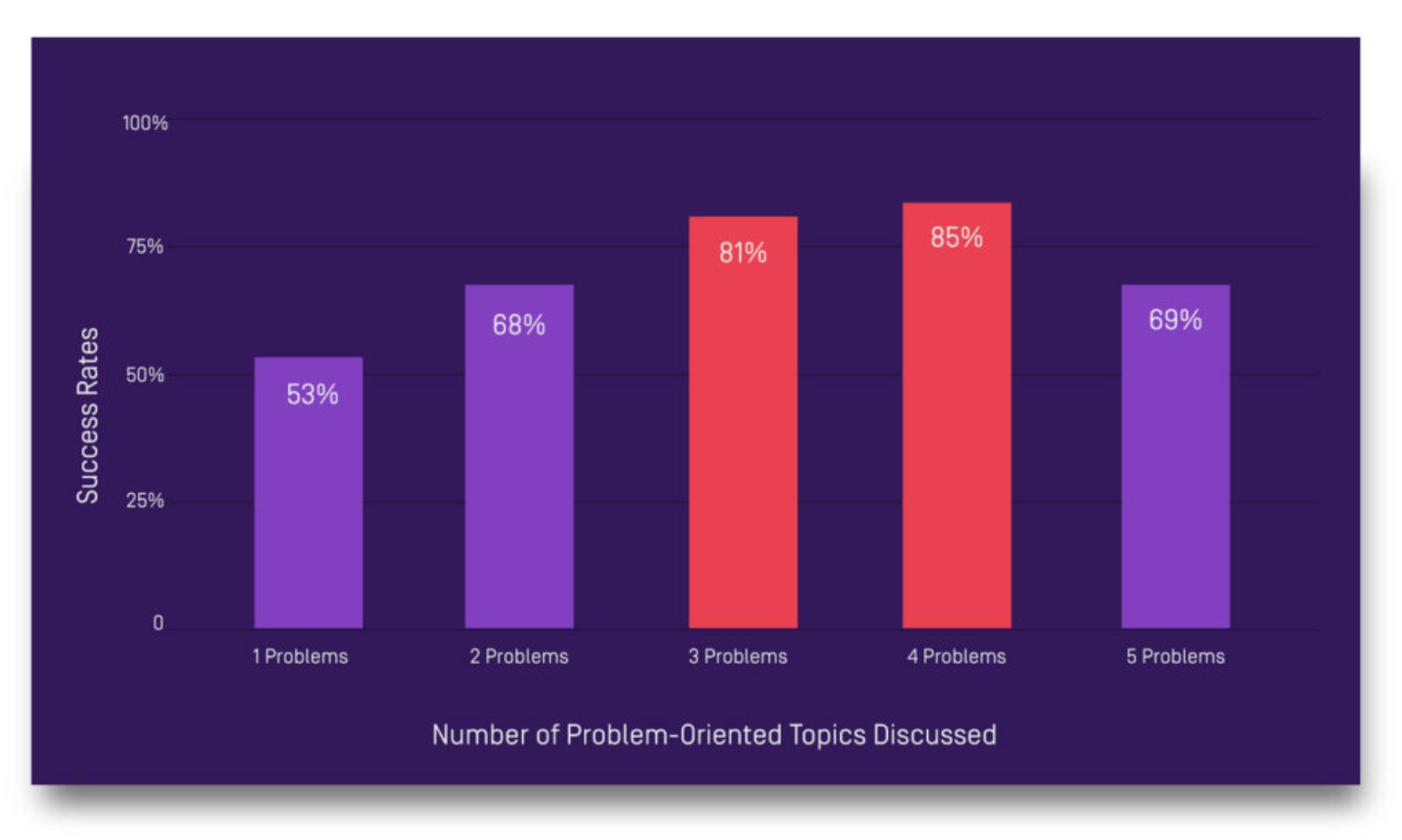
Ask 11-14 questions in total about those areas.
Our data shows that asking more questions than that is detrimental to your deal.
And fewer questions won’t get you the juicy information you need during discovery:
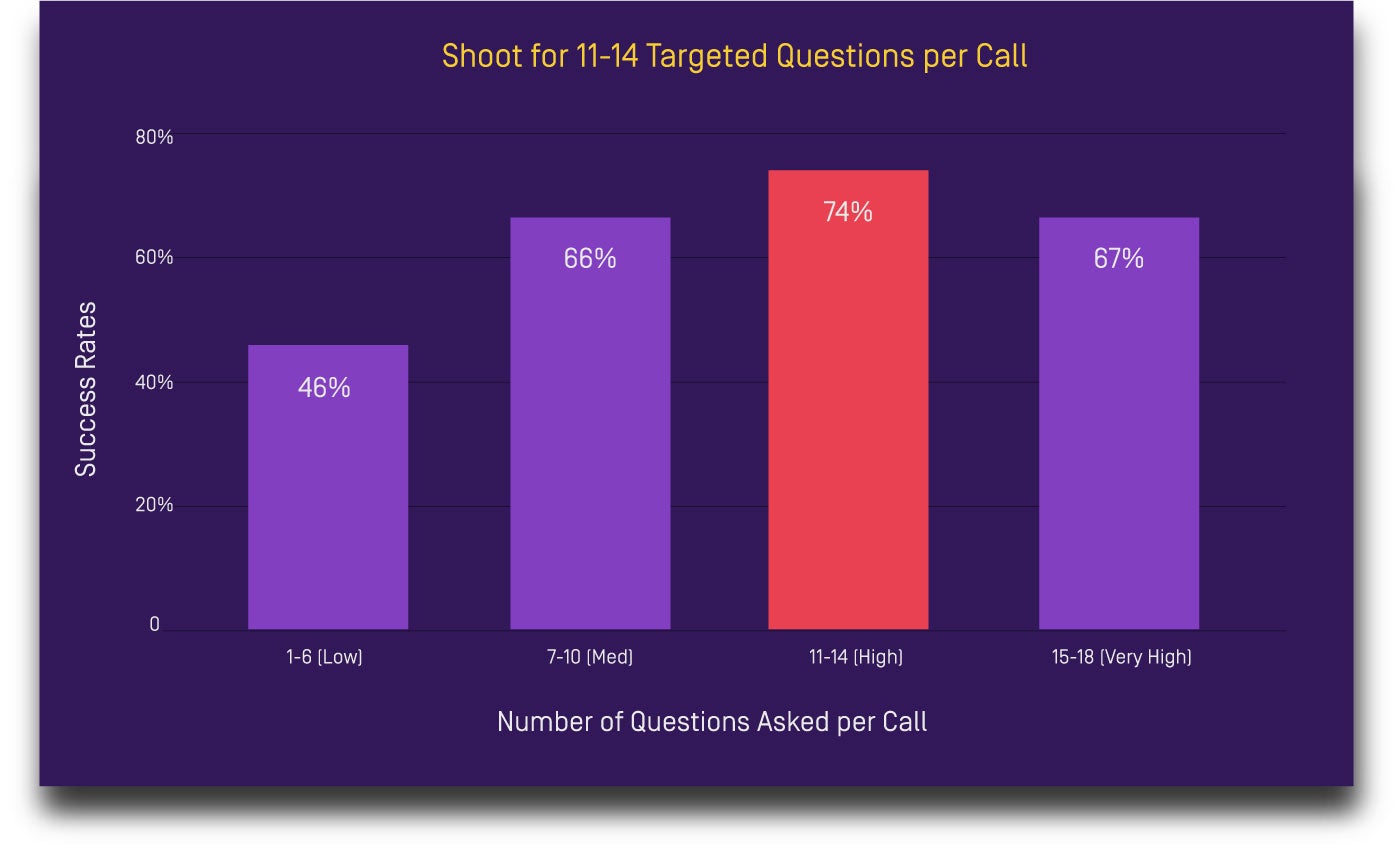
You may be surprised by what your prospect reveals during a comfortable, natural, two-way conversation.
Sales call tip #9: ask the right kind of questions
The right kind of sales questions are those that get you as much bang for your buck as possible.
Imagine that every question you ask withdraws from your prospect’s emotional bank account.
Ask too many, and they’ll feel like you’ve been interrogating them.
So, here’s a tip to ask your questions in a way that gets as much value as possible for each one:
Phrase your questions in a way that encourages long responses. Here are some examples:
- Can you help me understand your biggest challenges when it comes to sales effectiveness?
That’s sure to get you a better response than just “What are your biggest challenges when it comes to sales effectiveness?”
The “Can you help me understand” phrasing at the beginning signals to your prospect to go in-depth.
Here are a few other phrases to tee up your questions that will have the same effect:
- Can you help me understand…
- Can you walk me through…
- Talk to me about…
Get more examples in these 3 sales call scripts.
Sales call tip #10: distribute your questions evenly across the sales call
This is not a speed round Q&A.
Have a normal conversation, even if you have highly targeted questions.
Top performers ask questions throughout the conversation because it feels natural and relaxes the prospect.
Average performers lob rapid-fire questions at their prospects right from the start:
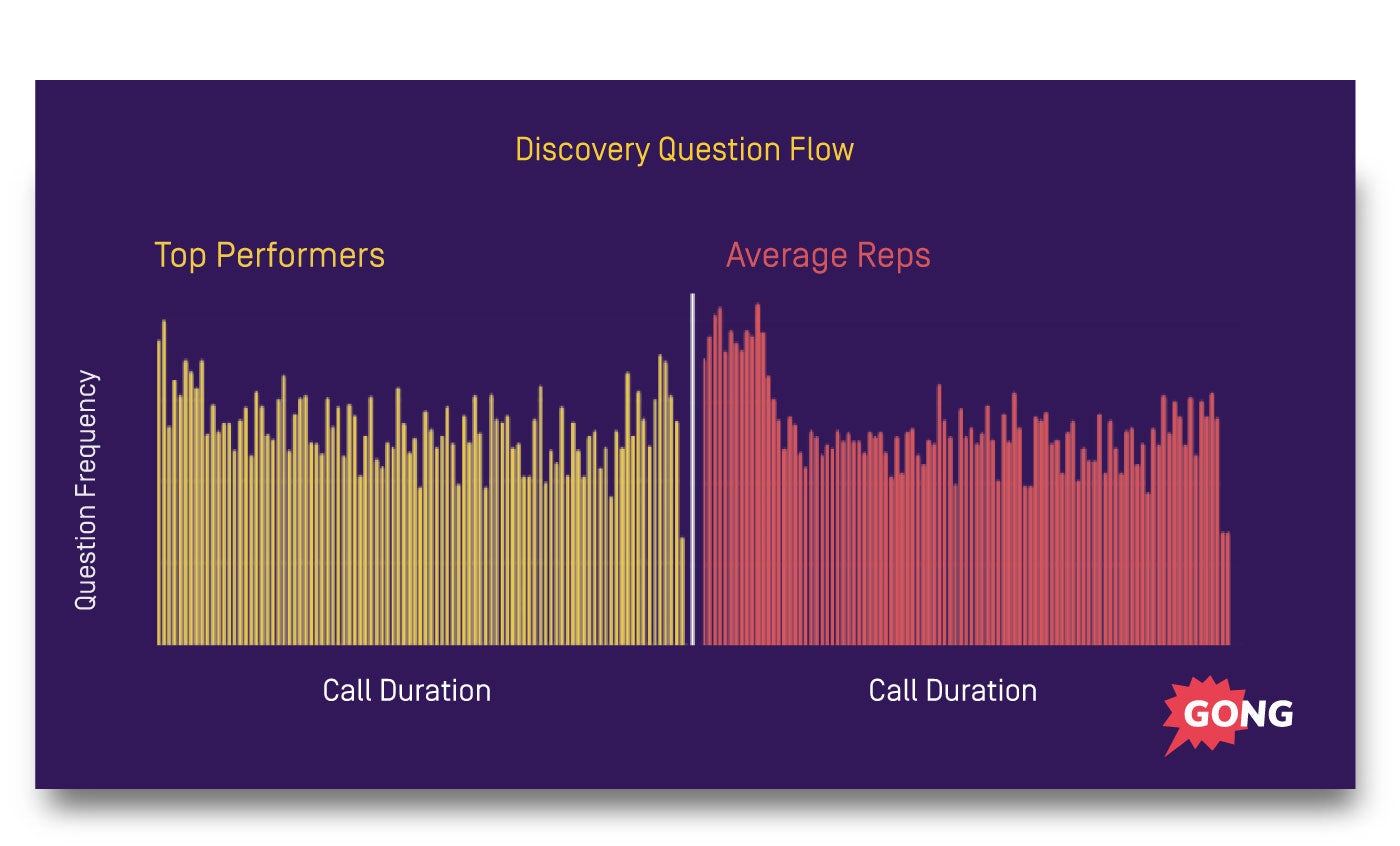
Repeat after me:
“I will not ask questions like I’m completing a checklist.”
Have a regular conversation with stellar questions thrown in now and again.
Sales call tip #11: turn on your webcam
I’ve seen this one become more popular the last two years.
During web conference sales meetings, it used to be that no one would ever turn on their webcam.
This is a shame, because it’s incredibly difficult to build rapport without seeing the other person.
If you sell remotely via web conference or call software (rather than face to face), flip on your webcam.
Your customer will usually follow suit.
Feel like it’ll be awkward?
All the more reason to try it.
As they say, “Everything you want is just outside your comfort zone.”
Sales call tip #12: use downward inflection
Ending your sentences and questions on a high pitch note robs you of your authority and ability to command respect.
It’s an approval-seeking behavior, and it feels repelling to your prospects (and anyone else for that matter).
Instead, end your sentences and questions with a downward (or neutral tone), making sure you’re not coming across as overbearing or too authoritative.
When you do this right, your prospect will see you as a high-status individual, which puts you in a much more powerful position to persuade.
Sales call tip #13: talk value, not features
Say something worthwhile.
Though features are important, it’s what your prospects can do with features that really matters. They’re a means to an end.
Have a conversation about business value instead of features.
That’s what top reps do 52% more often than their peers:
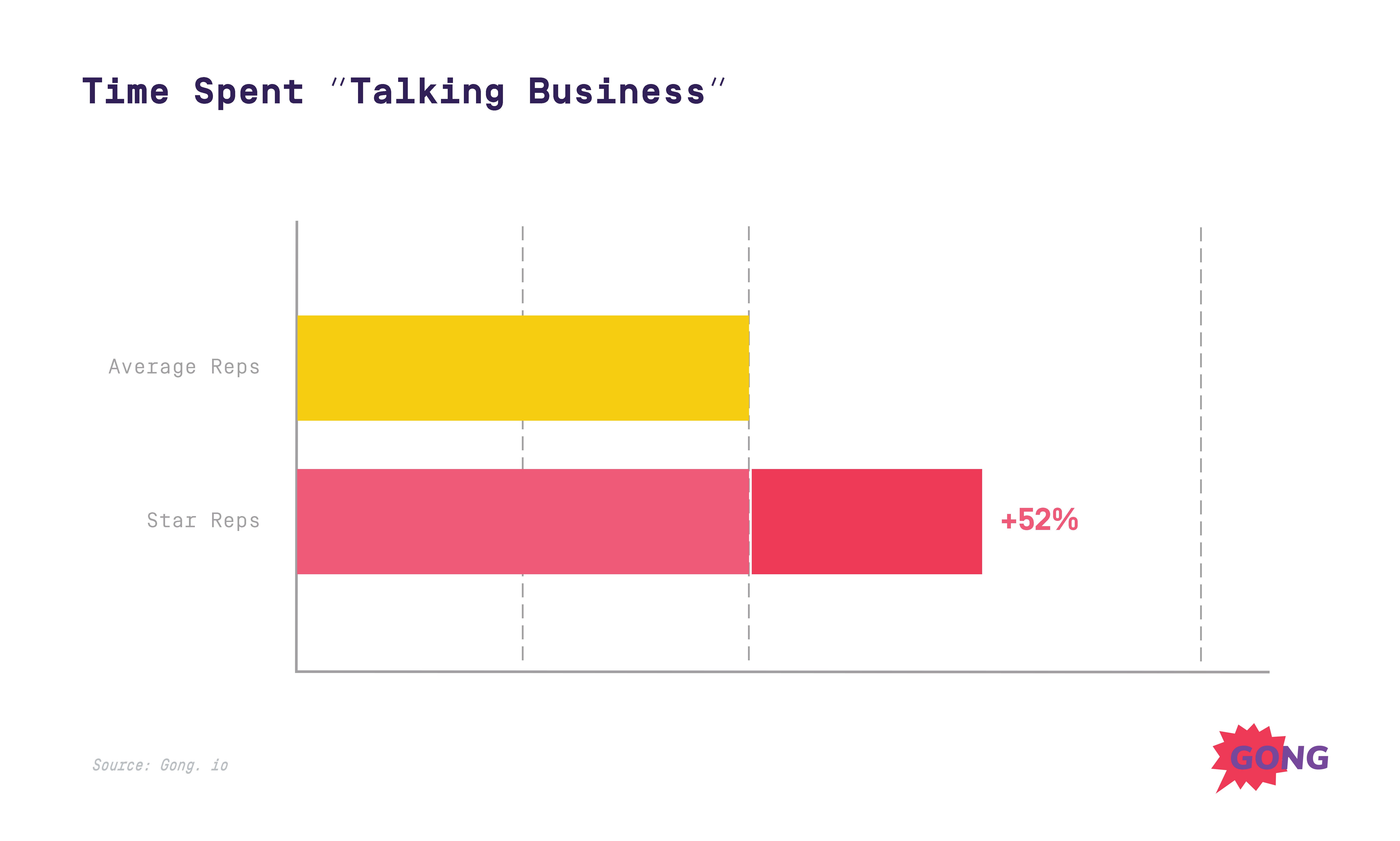
Business value topics includes these categories:
- Return on investment (ROI)
- The buyer’s business challenges
- The buyer’s business environment
- The buyer’s decision-making ecosystem
- Ongoing support and project implementation
- Value-related topics (as opposed to feature-related topics)
Less-than-stellar salespeople talk far too much about product features and technical details:
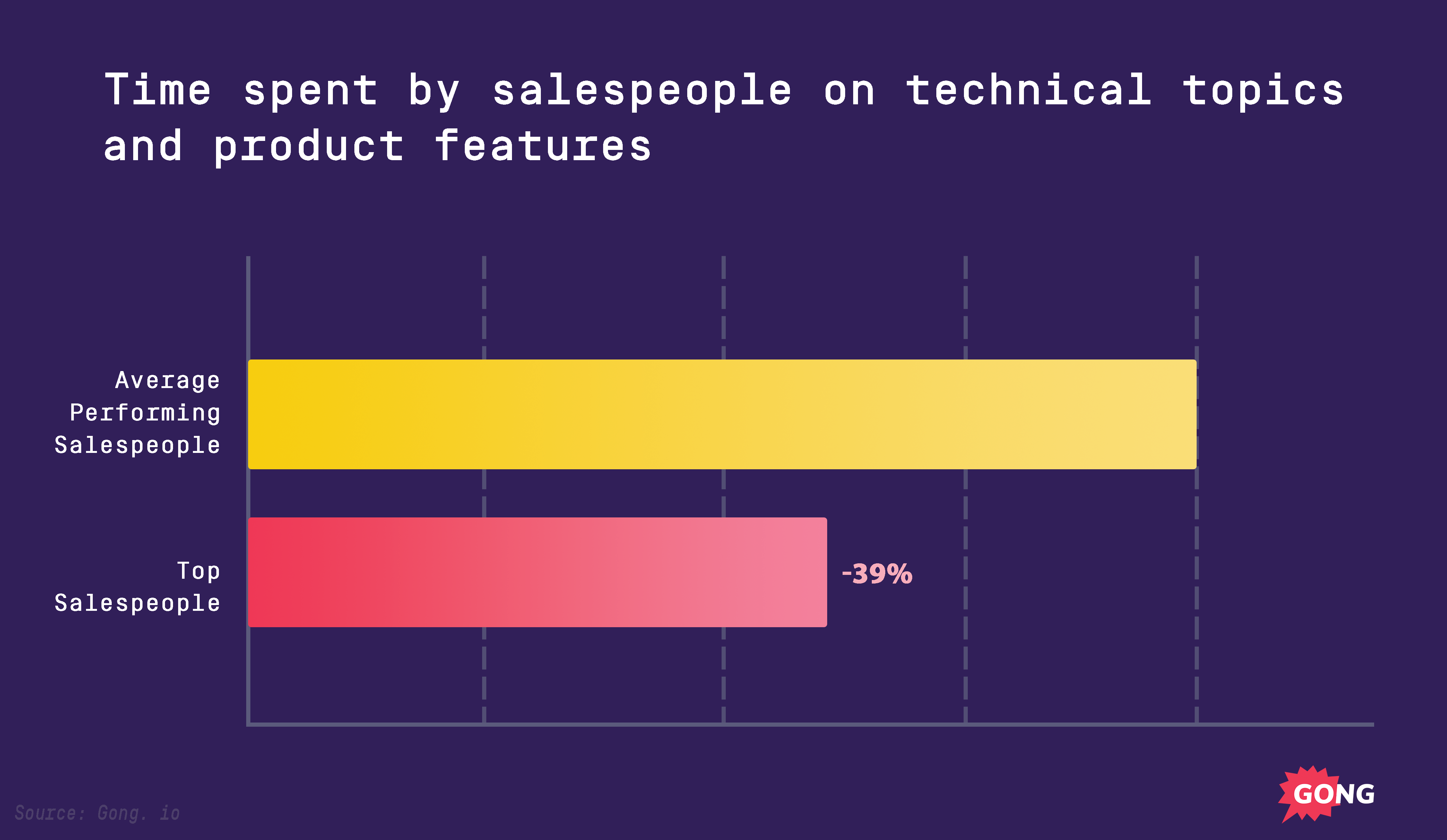
The top reps (those above 120% of quota) discuss those topics 39% less often.
Our data shows that reps who switch from talking about features to talking about business value move up in their teams’ rankings.

Shifting your habit from talking about features to talking about business and value is the number one way to go from good, to great.
Sales call tip #14: ask your manager to join your sales call
Share the limelight. It’ll boost your ability to close deals.
By how much?
A whopping 258%.
Yep. You read that correctly.
It’s one of the most impressive metrics in this article.
Inviting team members to join just one call in your sales cycle has that effect:
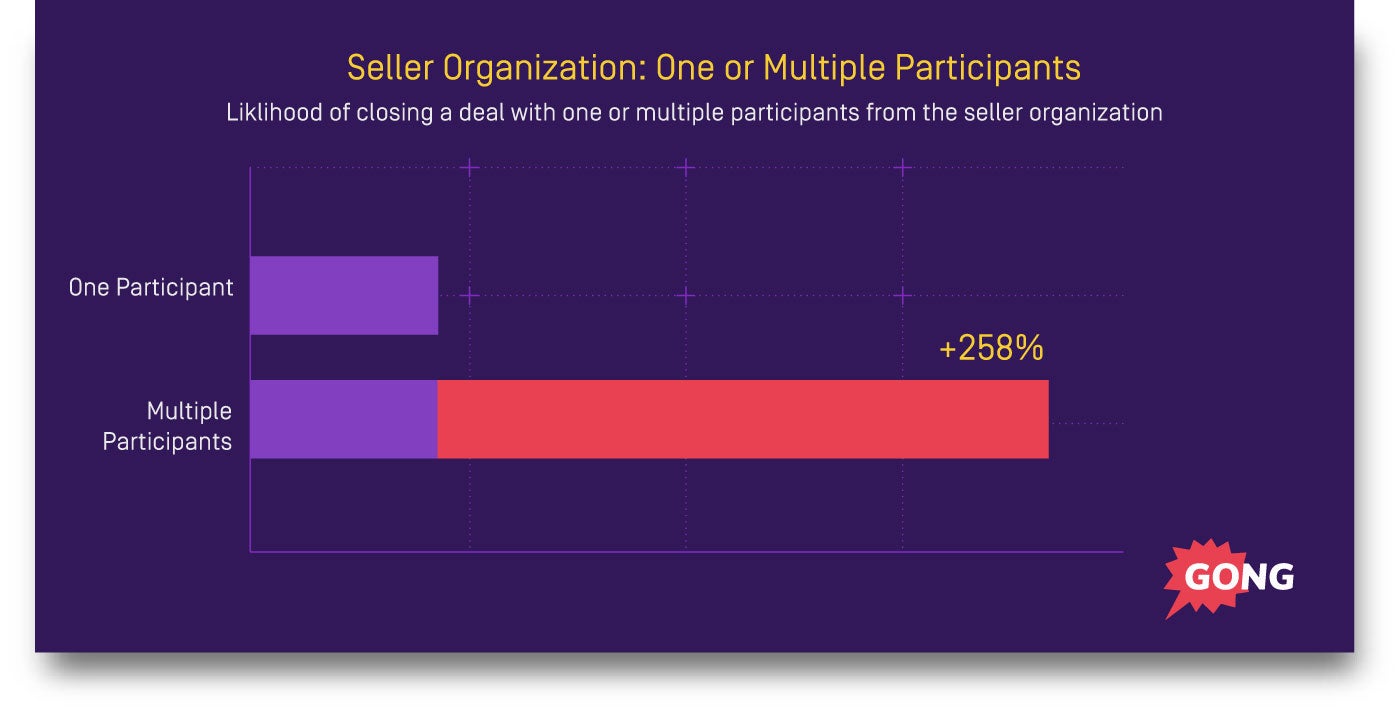
Team selling works.
We promise.
The only time you don’t want to do it is during the discovery call.
That’s when one seller and one prospect works best.
Having more people on the discovery call can actually drop your win rate by 23%:
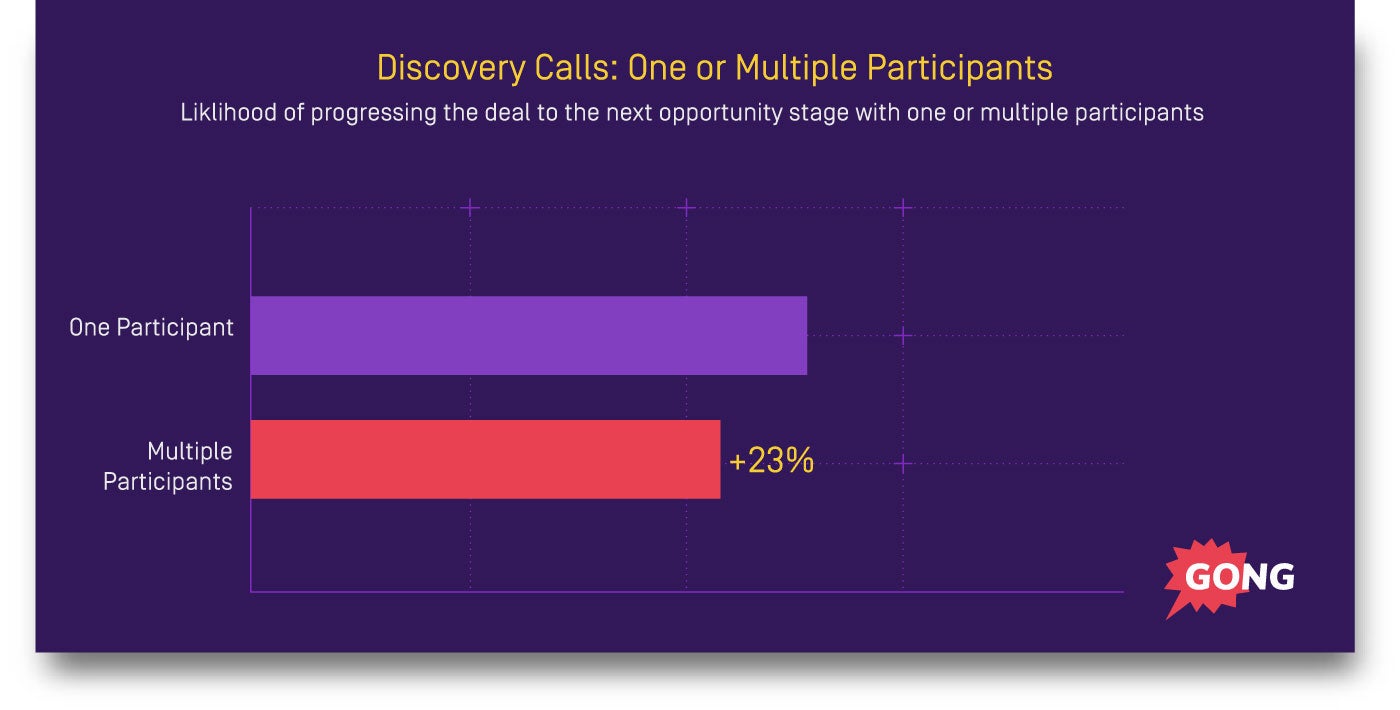
Otherwise, make it a team effort for at least one call in your sales process.
Do it early in the cycle.
And if you’re pressed for time, use this tactic for your most important prospects.
Because 258%!
Sales call tip #15: use a voice that commands respect
This is similar to sales call tip #12.
You want to sound like someone who commands respect.
Having a high pitched, approval-seeking tone screams “I’m an approval-seeking salesperson!”
You should aim to sound like a high power executive.
Imagine a detective who’s investigating a crime calling you on the phone.
They’re unlikely to have a weak, high pitched voice.
They probably sound somewhat authoritative.
You should strive to do the same thing, while maintaining your warmth and approchability.
Sales call tip #16: disarm your competition early in the sales call
This sales call tip is going to surprise you.
Don’t shy away from discussing the competition.
Talk about them early in the sales cycle.
It will make you 49% more likely to win a deal than ignoring them altogether:
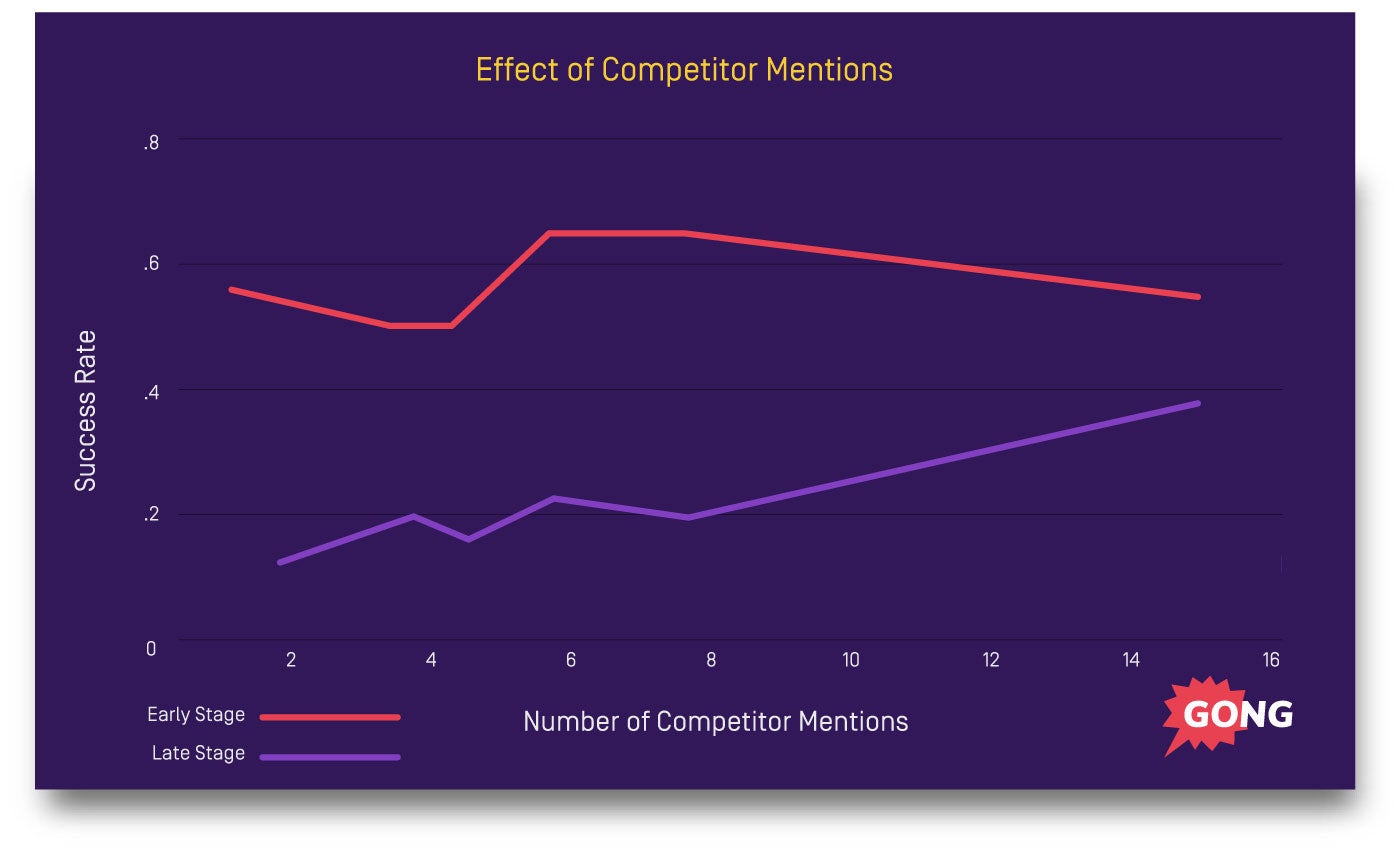
When you bring the competition up early on, you can affect how the prospect thinks about them.
But don’t mention them in the middle or at the end of the sales cycle.
That’s worse than if you ignore them altogether:
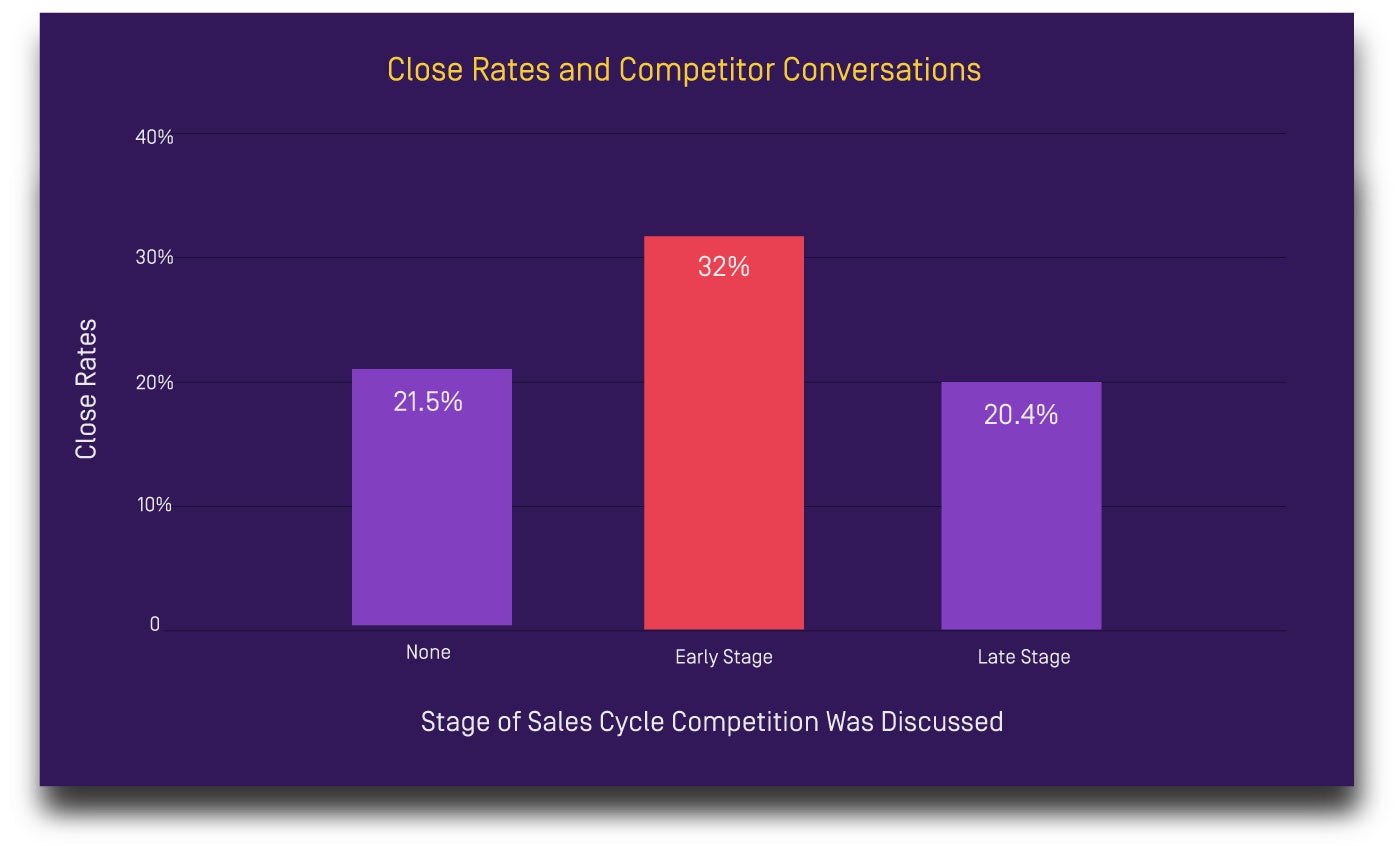
Ask who else they’re considering early on and you’ll be able to shape your prospect’s buying criteria before it’s set in stone.
Sales call tip #17: avoid a nervous monologue after objections
If your prospect’s objections feel like a terrifying pop-up in a haunted house, take heed.
Objection handling situations are actually a good thing.
They mean the prospect is intrigued and paying attention.
Here’s the best way to respond…
Make like a star rep and pause for ages longer than what feels normal:
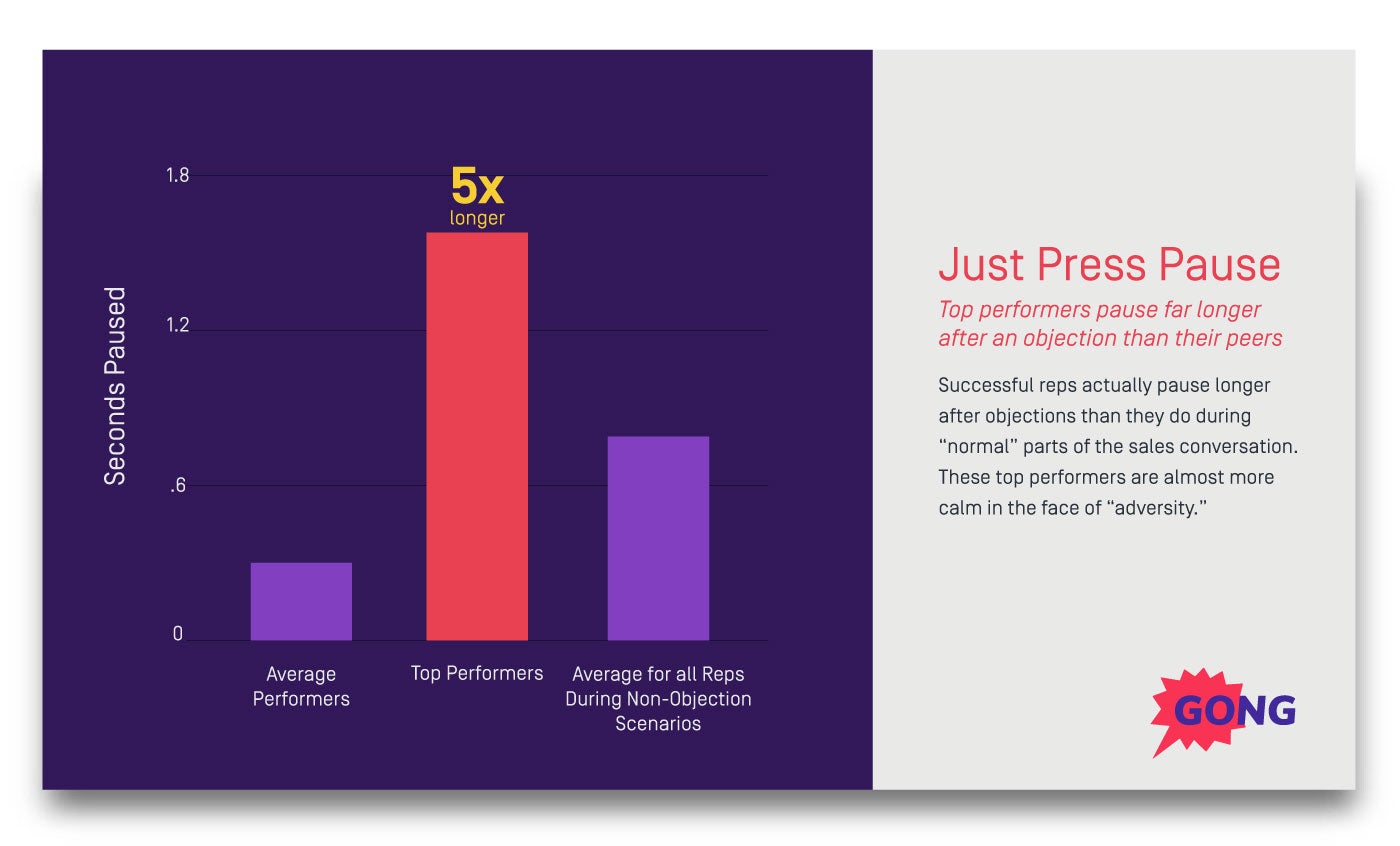
Don’t respond like a slingshot, or you’ll ramp up your talking speed to 188 words per minute and sound like you’re panicking.
Instead, slow your roll like a top rep:
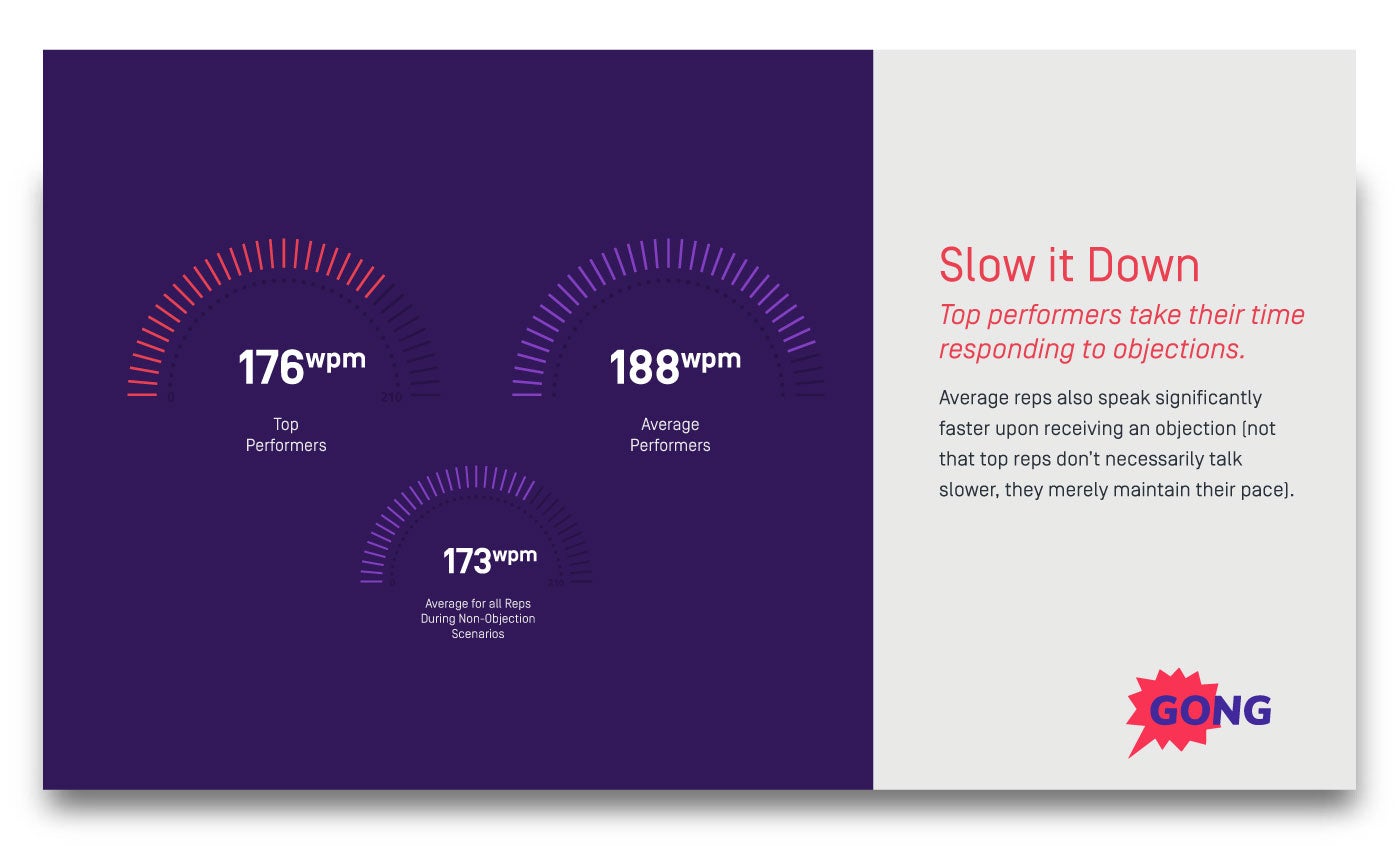
And definitely don’t respond with an uninterrupted monologue.
Our data shows that it’s ineffective:
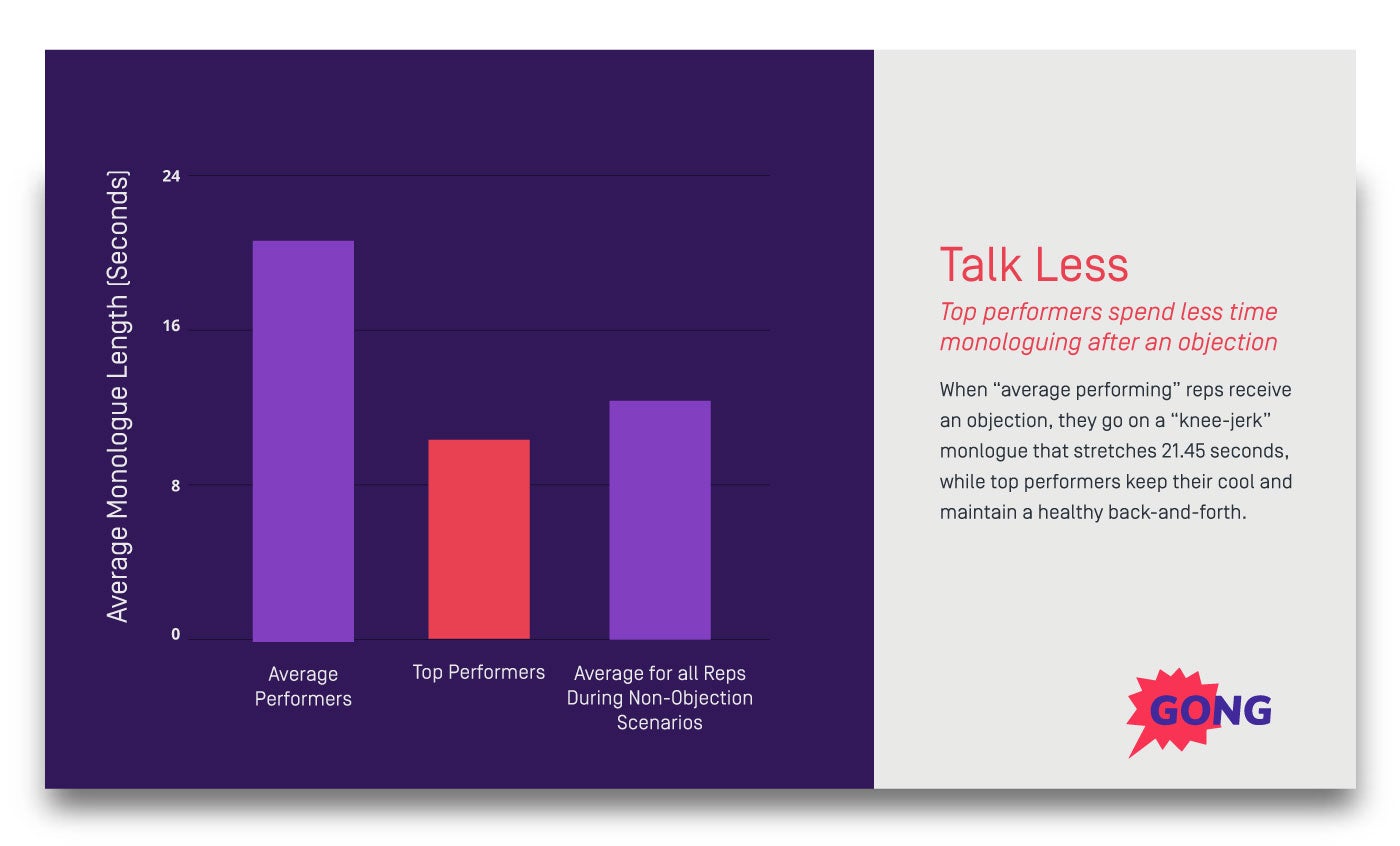
Roll with objections.
Make them work for you.
Sales call tip #18: respond to objections with questions
So what else is effective in the face of objections?
The best objection handling technique is to ask questions:
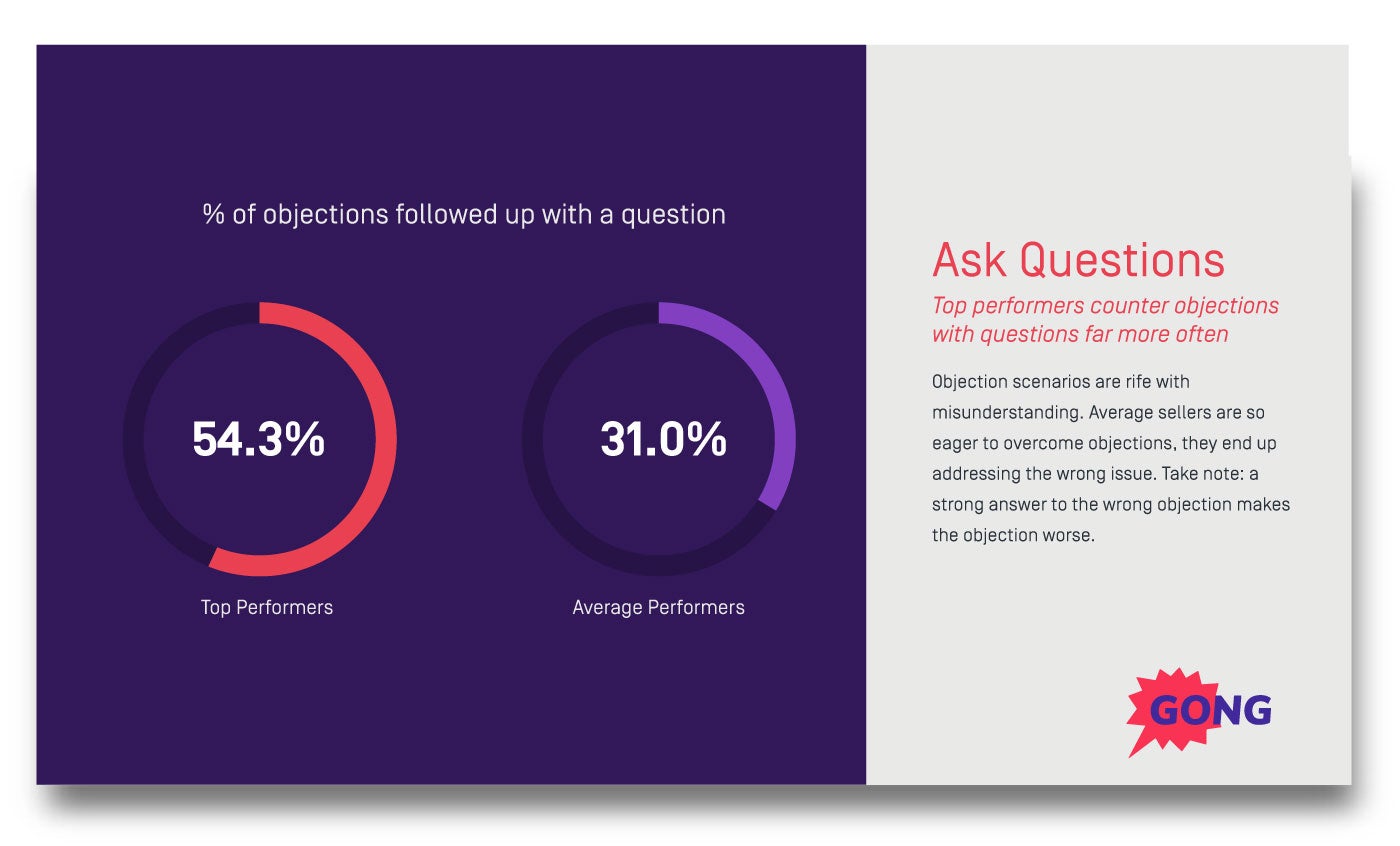
When you hear an objection, your goal is to keep a solid, two-way conversation going.
Be open about the challenges being raised.
It’s a great opportunity to discuss how your product solves the prospect’s problems.
Stay calm and keep your back-and-forth flow moving along steadily:
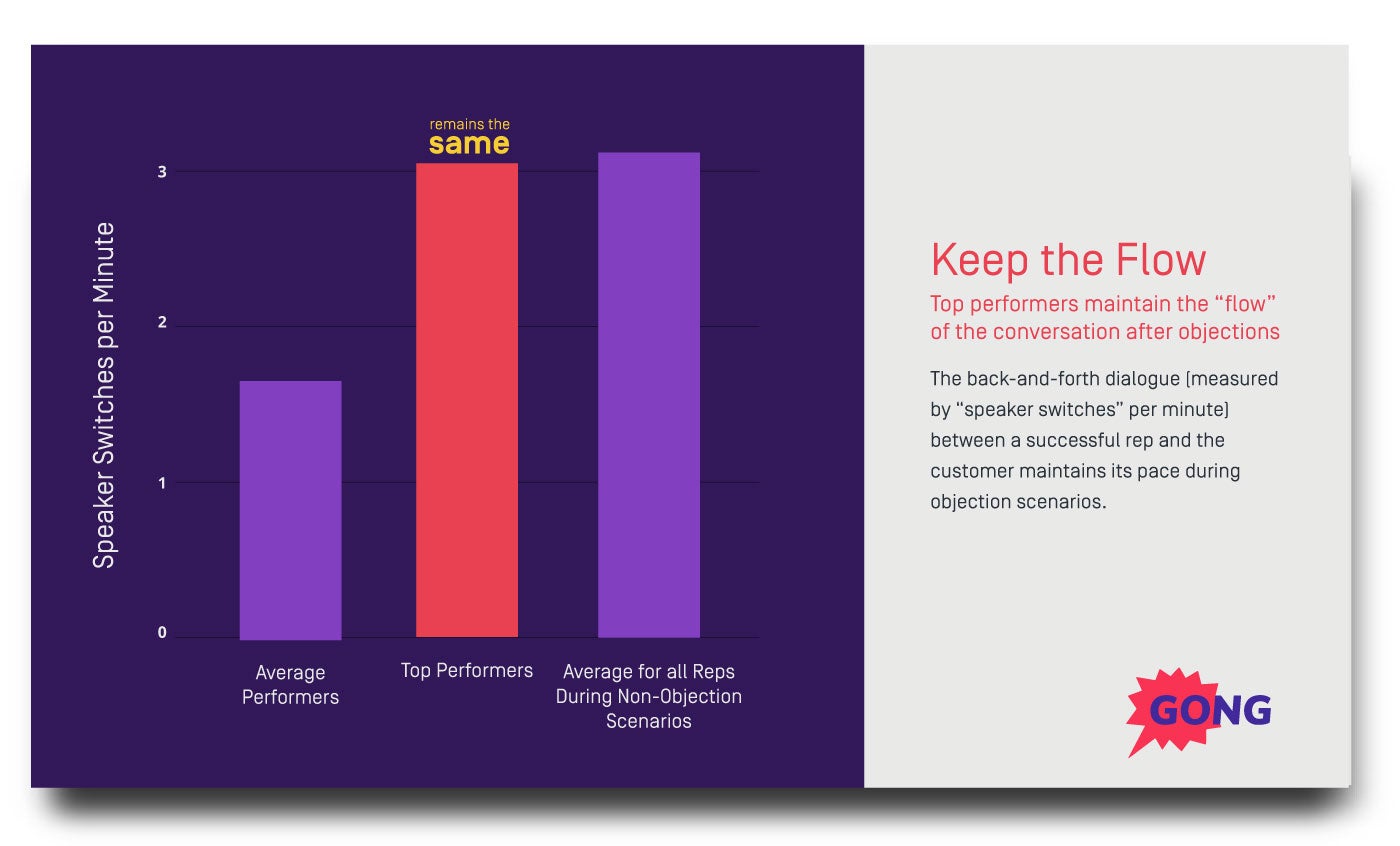
You’ve got this.
Sales call tip #19: make the sales call the right length
Most of us book meetings in 30- and 60-minute time slots.
Is one better than the other for moving the sales process along?
Nope. There’s no connection there.
But there is one important point to note:
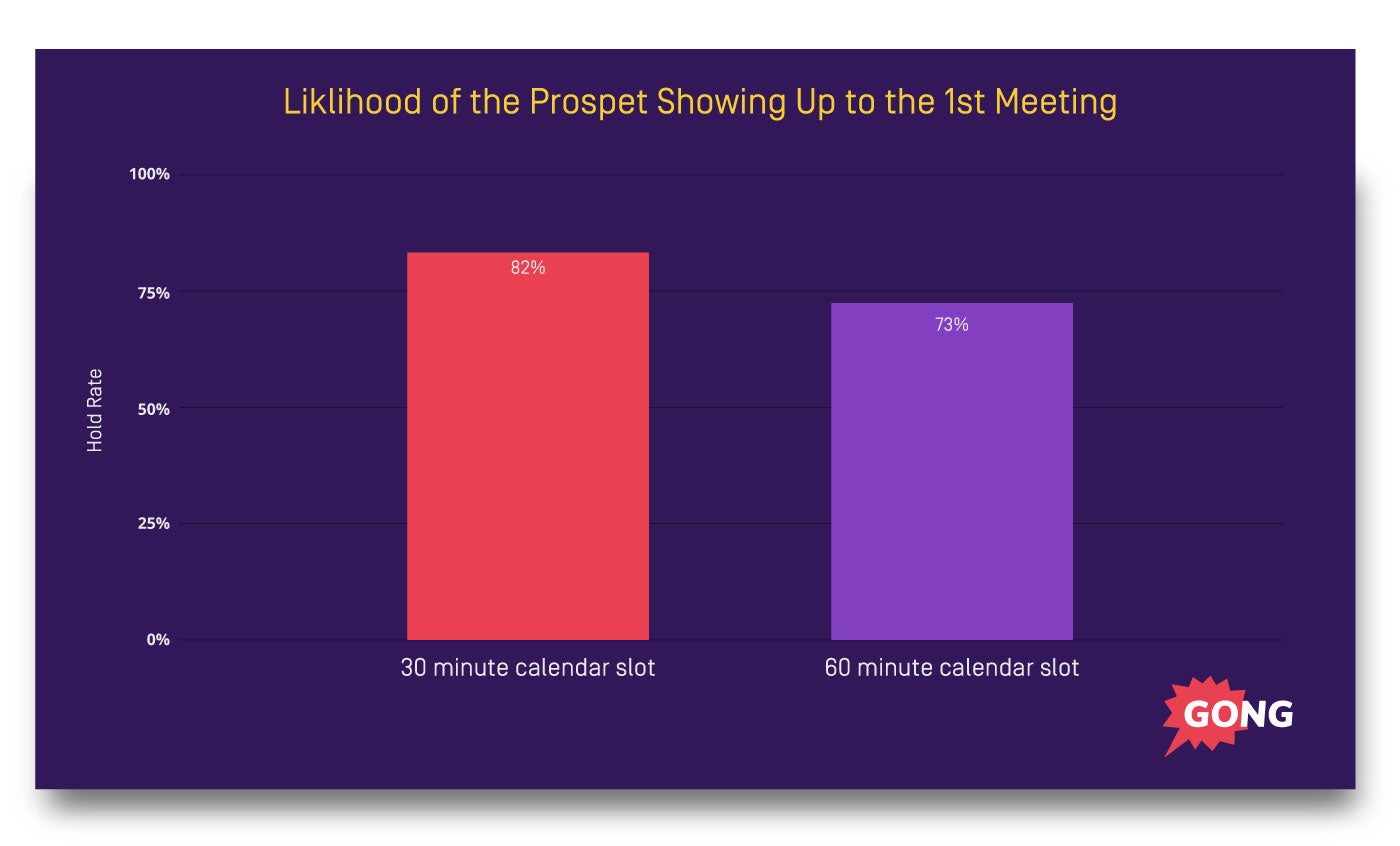
Your prospect is 12% more likely to show up for a 30-minute call than a 60-minute one:
Even if you have a complex product, keep it short.
Don’t cram everything into the first sales call.
Create a lean sales presentation and leave your prospect craving more.
Sales call tip #20: talk price late in the sales call
There’s one sticky little matter we haven’t touched on yet.
Pricing.
Raise it during the wrap-up in your product demo call, somewhere between the 38 and 46 minute mark.
That’s far better than raising it early on:
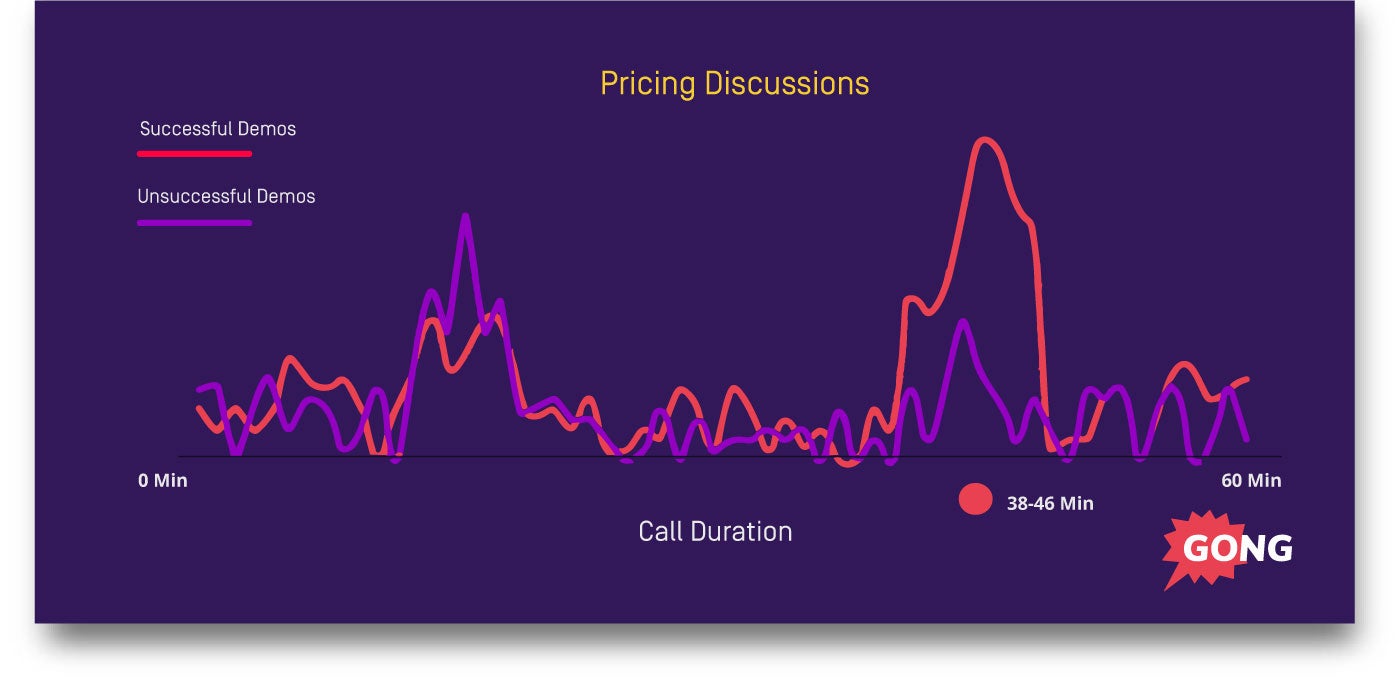
In unsuccessful demos, reps spend 8% longer on pricing.
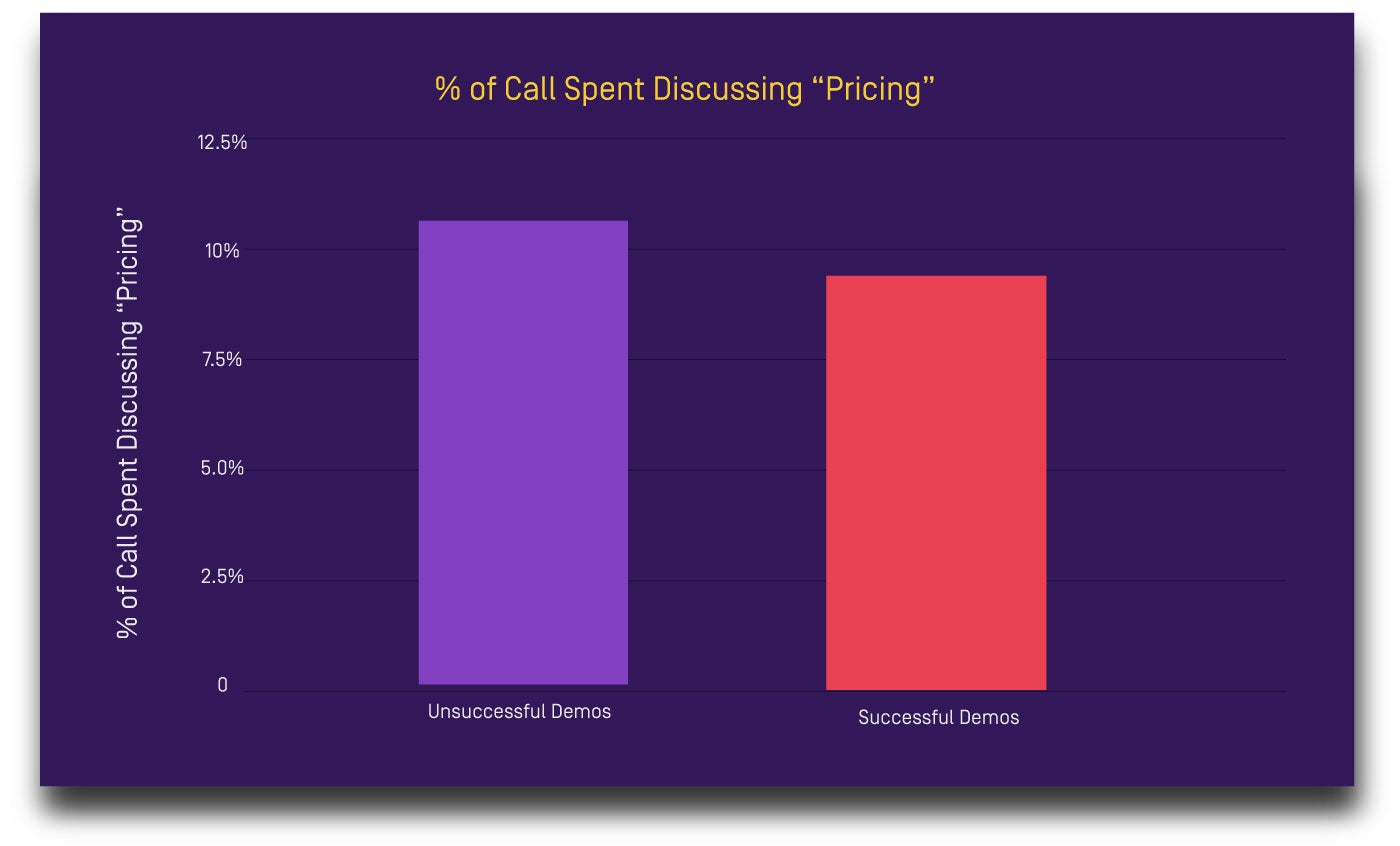
Why?
Because their inability to build value leaves them trying to win on price.
It should only take a few minutes at the end of a call to explain pricing and make the prospect feel like it’s fair.
Smooth out your talking points if it’s taking longer than that.
Sales call tip #21: plan next steps at the end of the sales call
The last sales call tip is to discuss your next steps.
Top performers spend 12.7% more time talking about next steps (as a topic of discussion):
It ties everything together at the end of the call and sets everyone up for moving the project forward together.
You can even condense your pitch to free up time for a ‘next steps’ discussion.
It’s that important.
Want even more effective sales call tips?
Take a bow.
With these 21 data-based sales call tips, you’re about to send your numbers skyward.
It seems like magic, but there’s no wizardry to it.
These sales call tips are based in science, and we’re delighted our data team uncovered them for you.
And if you want even more great advice, we’ve got you covered.
We asked 74 of the world’s greatest sales leaders for their best sales call tip.
And we put them all in this ebook.
Download it today!
If any of our 21 tips stood out for you, we’d love to hear from you in the comments below.
Share your thoughts, learn from your peers, and hit your quotas.
[newsletter]

